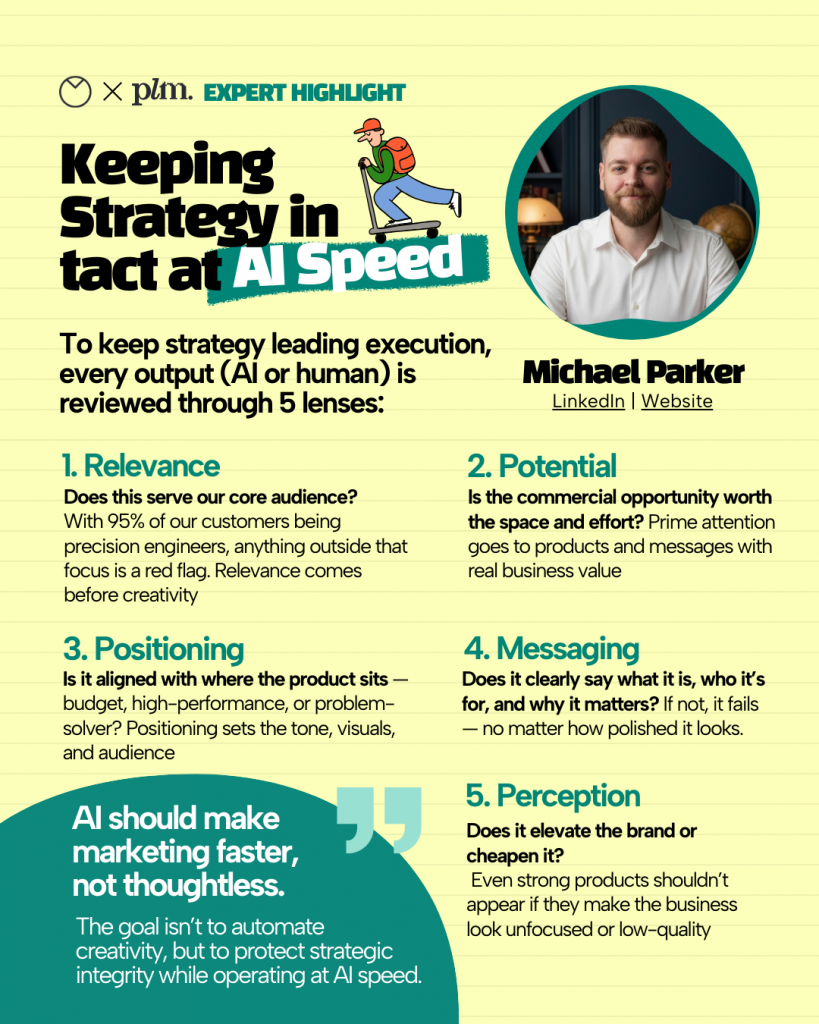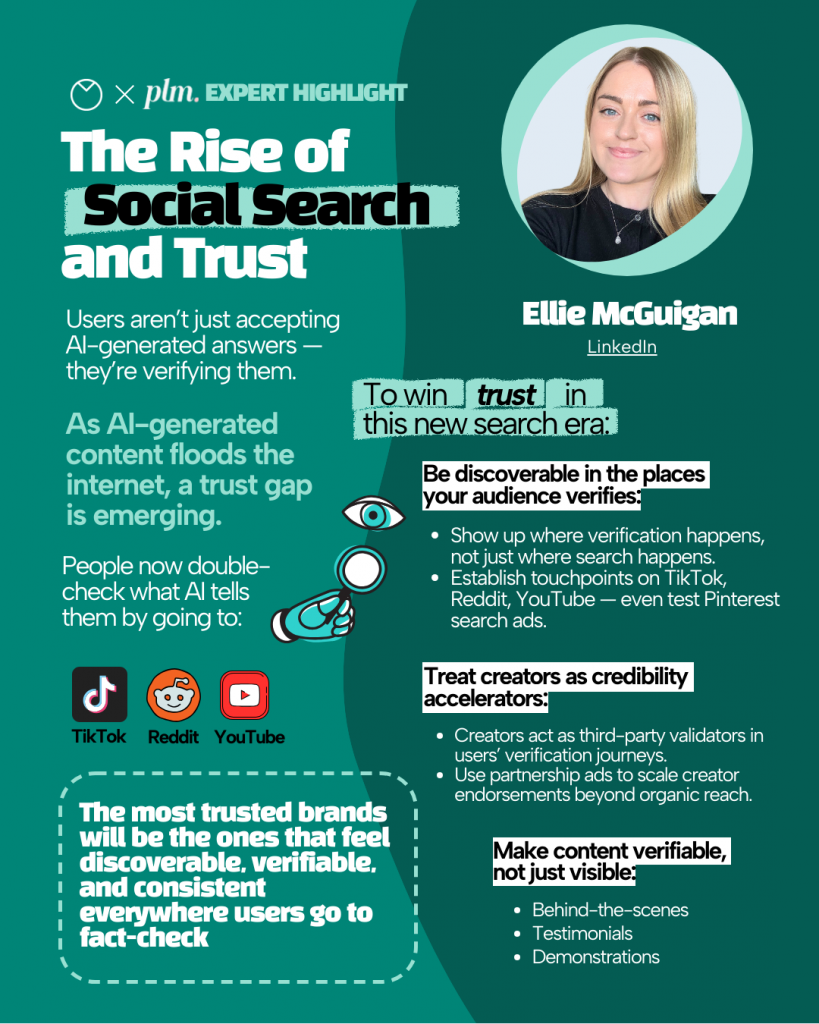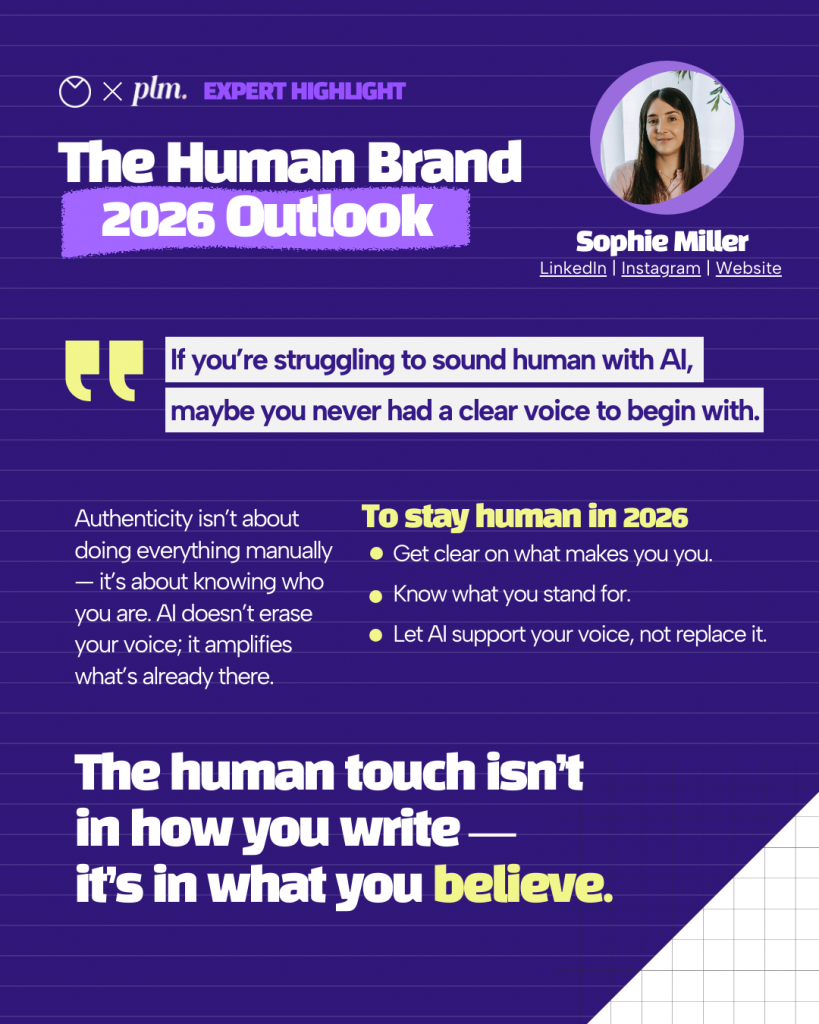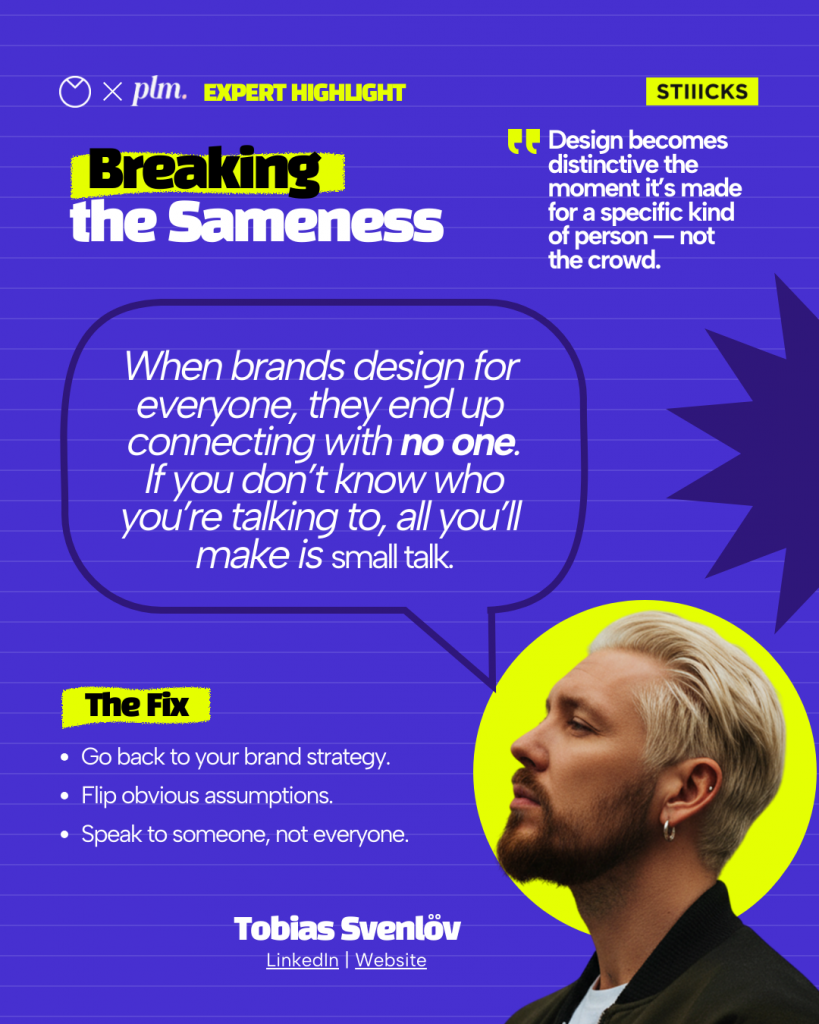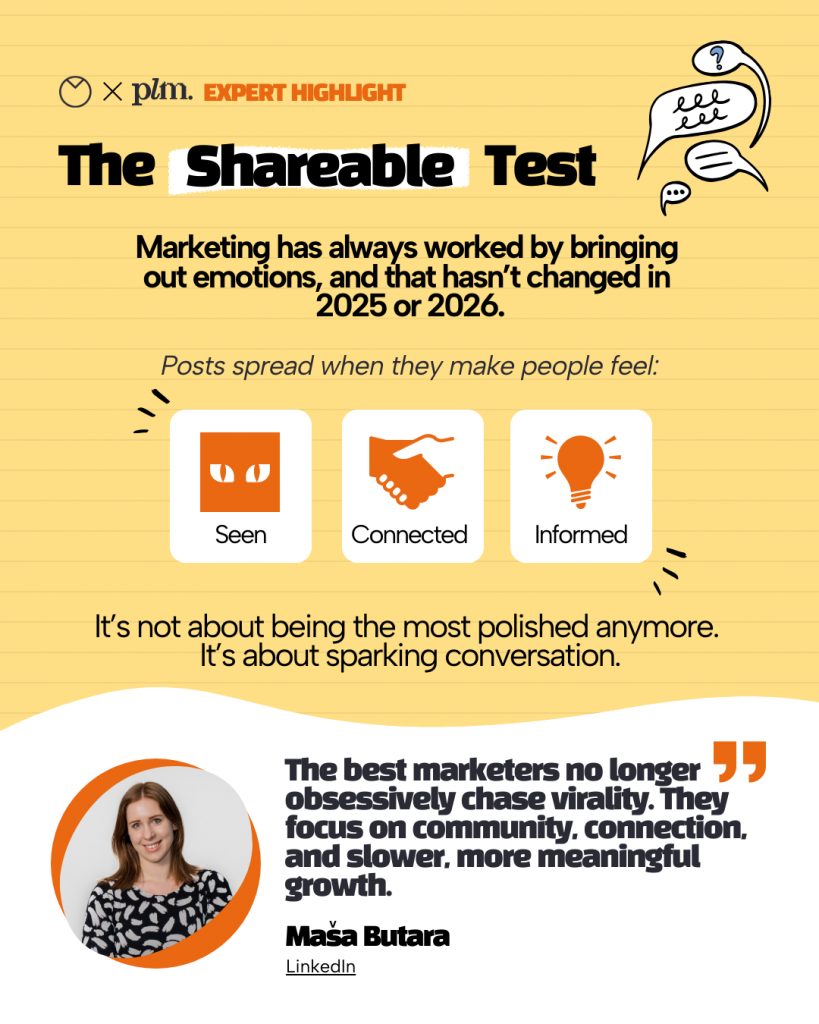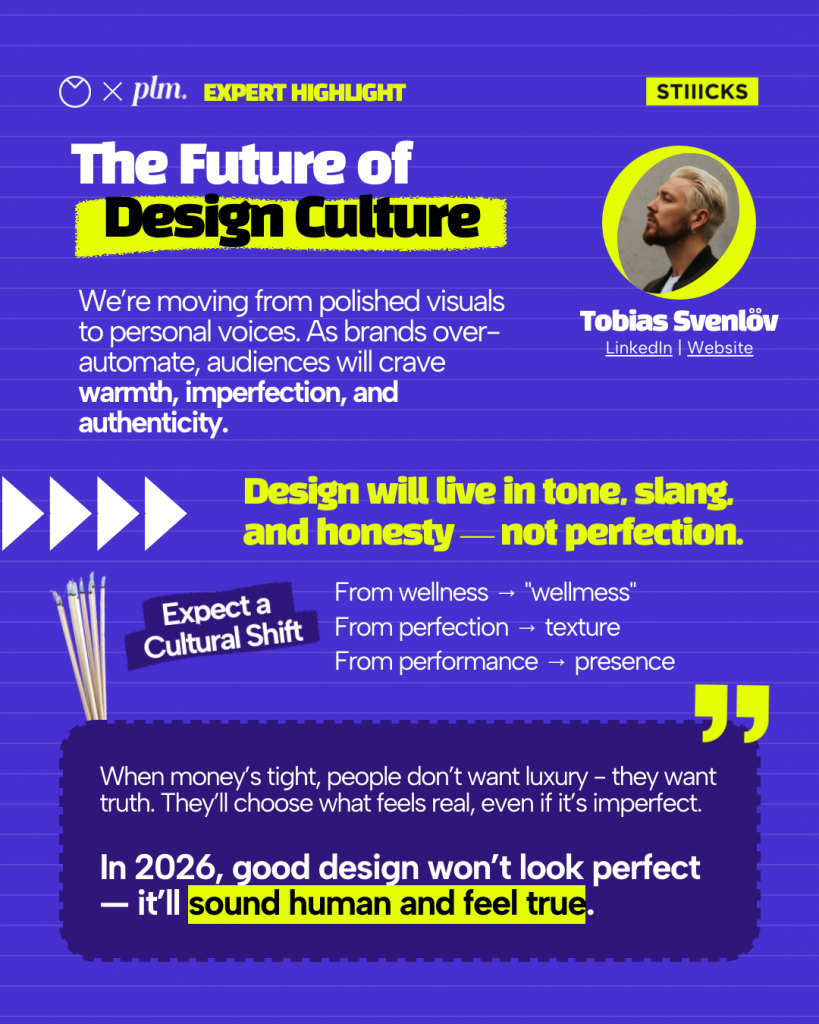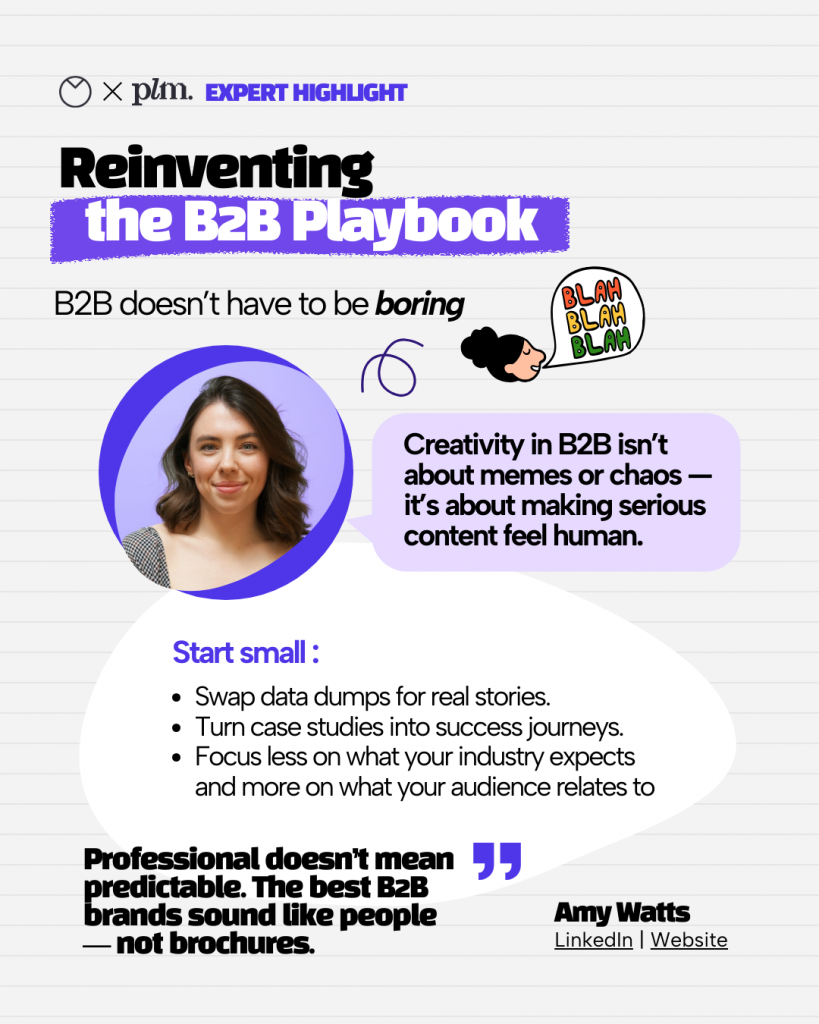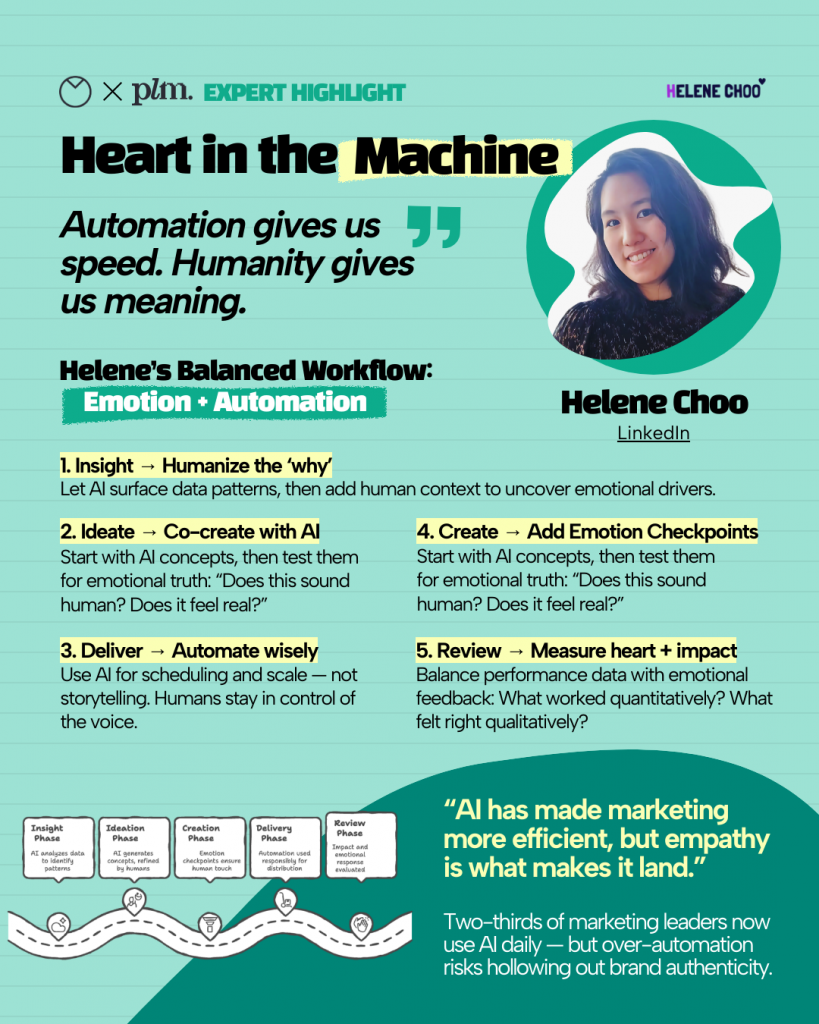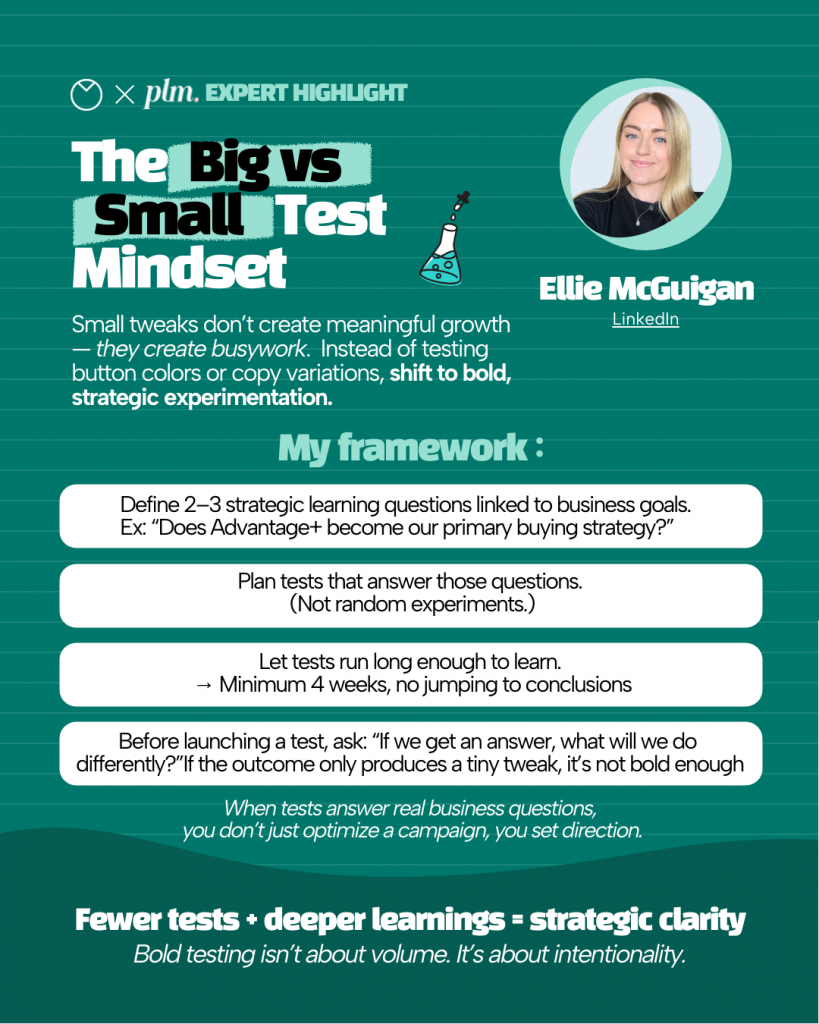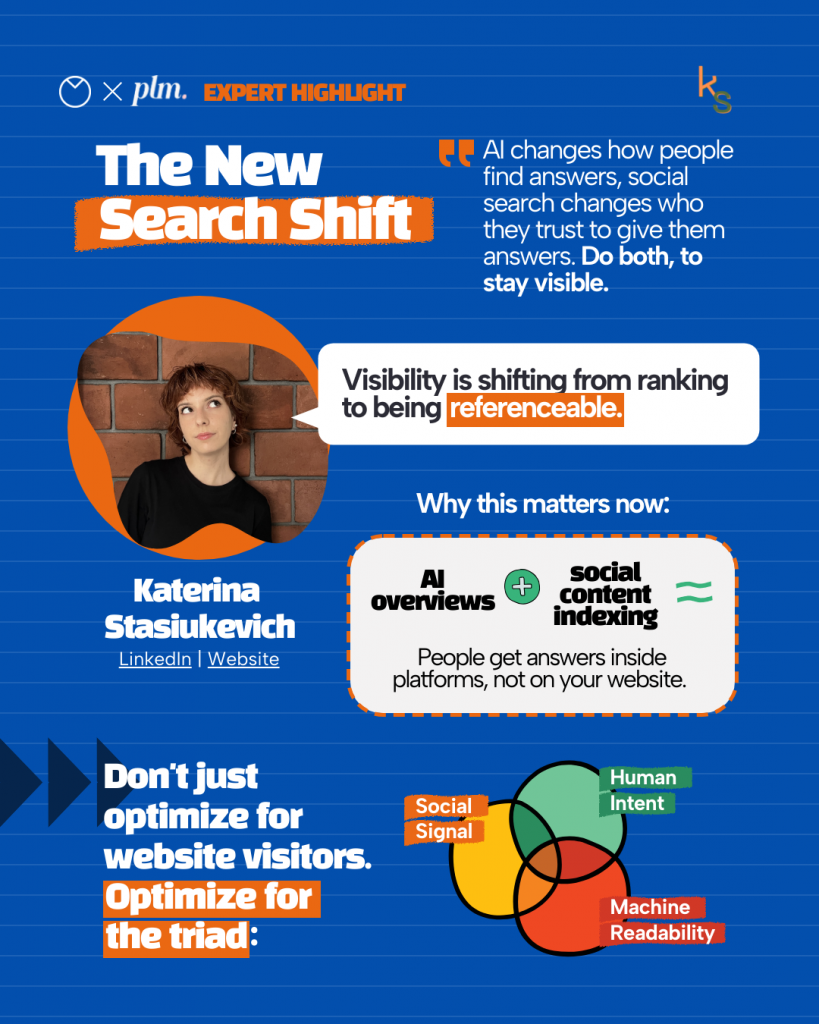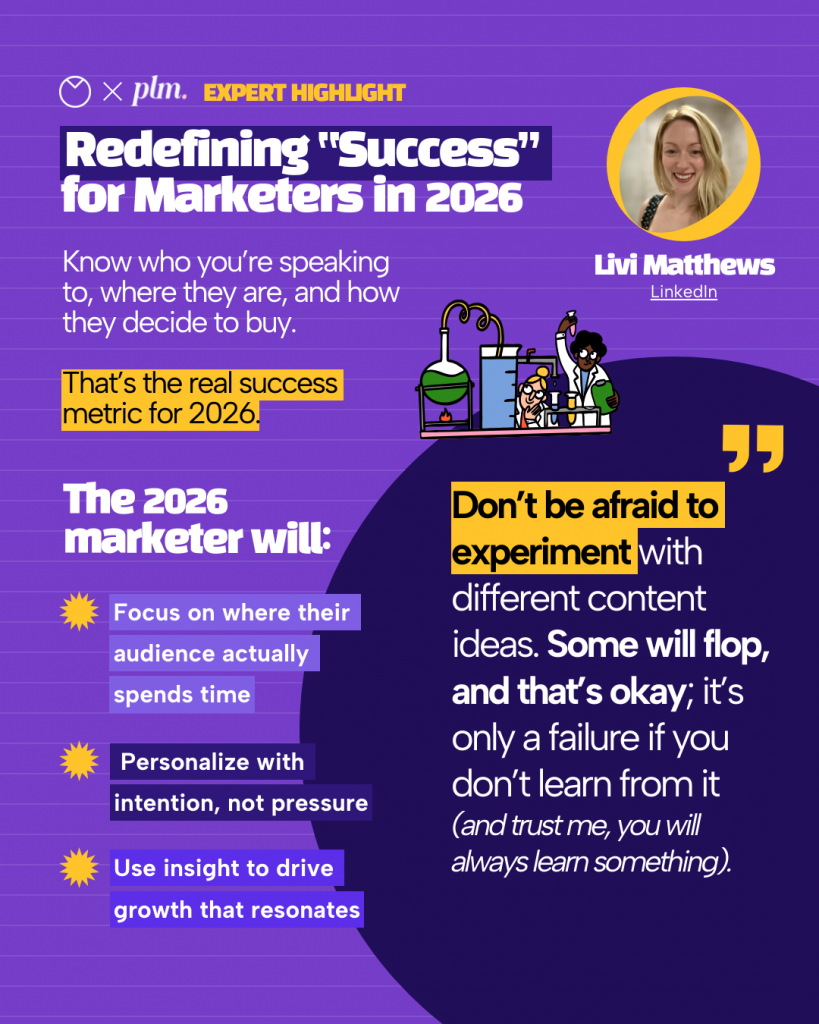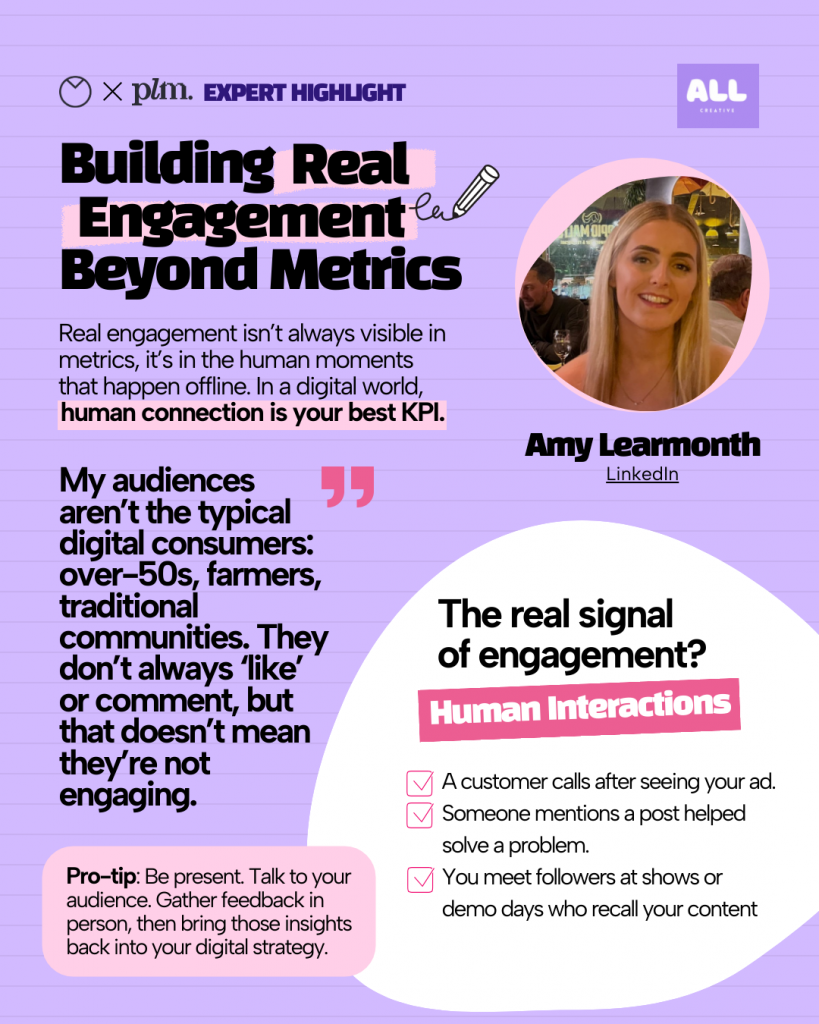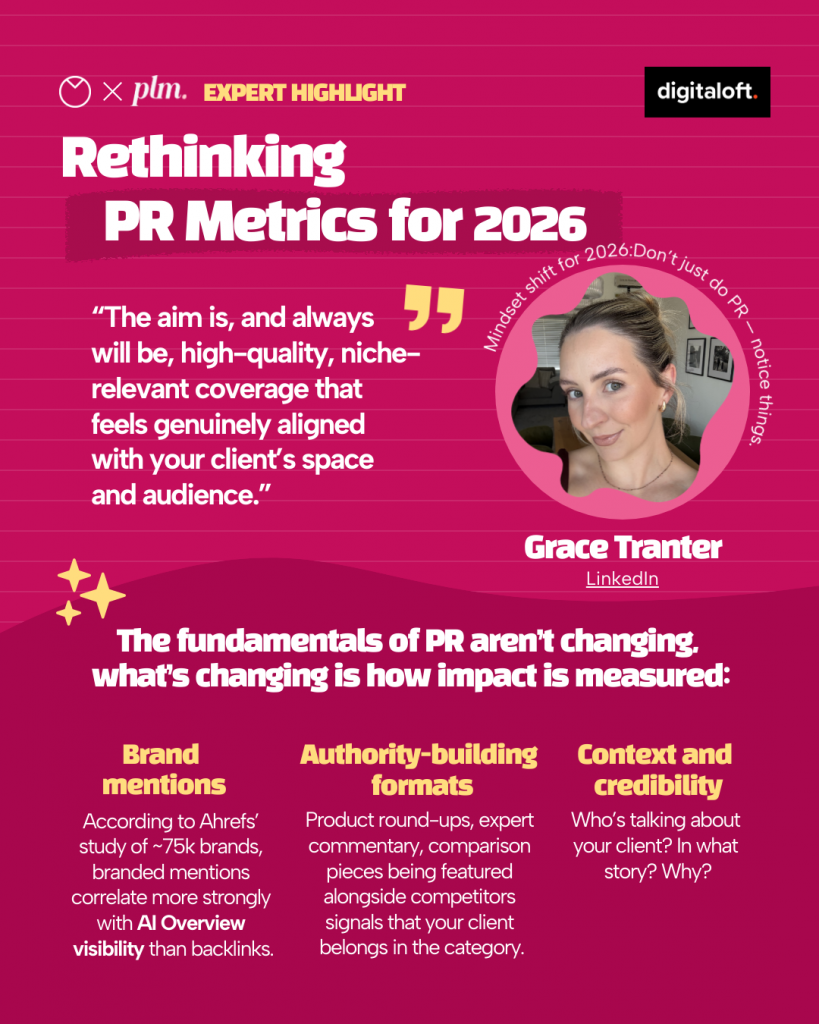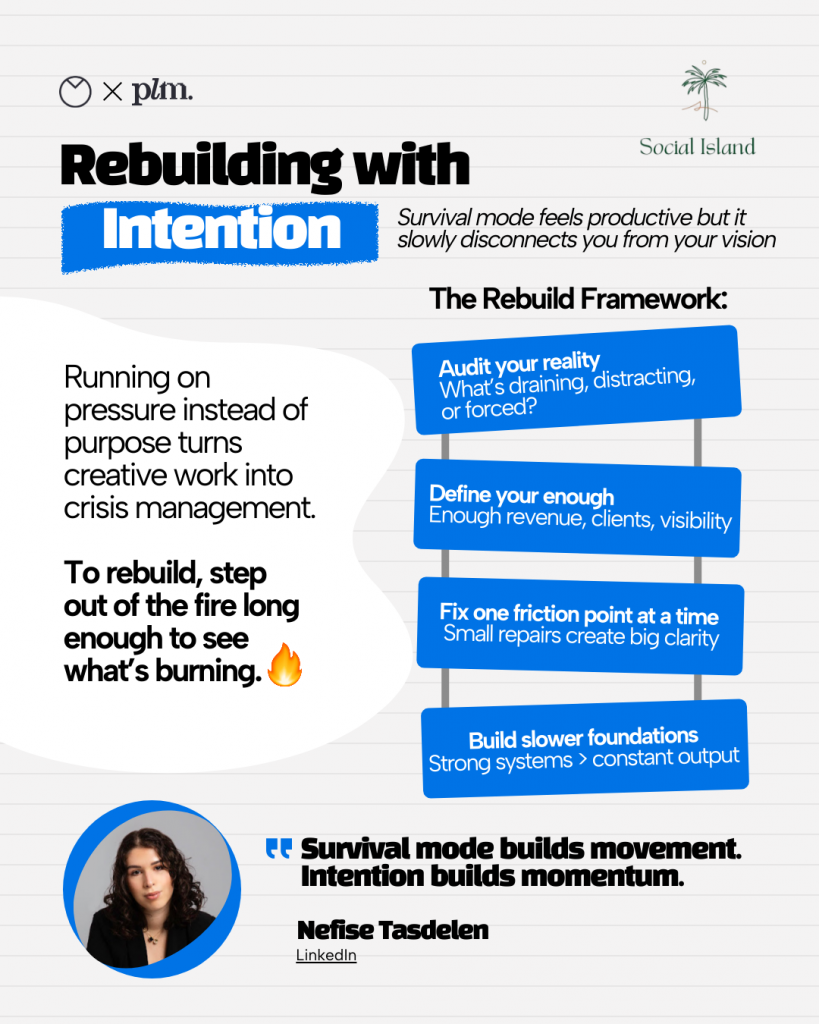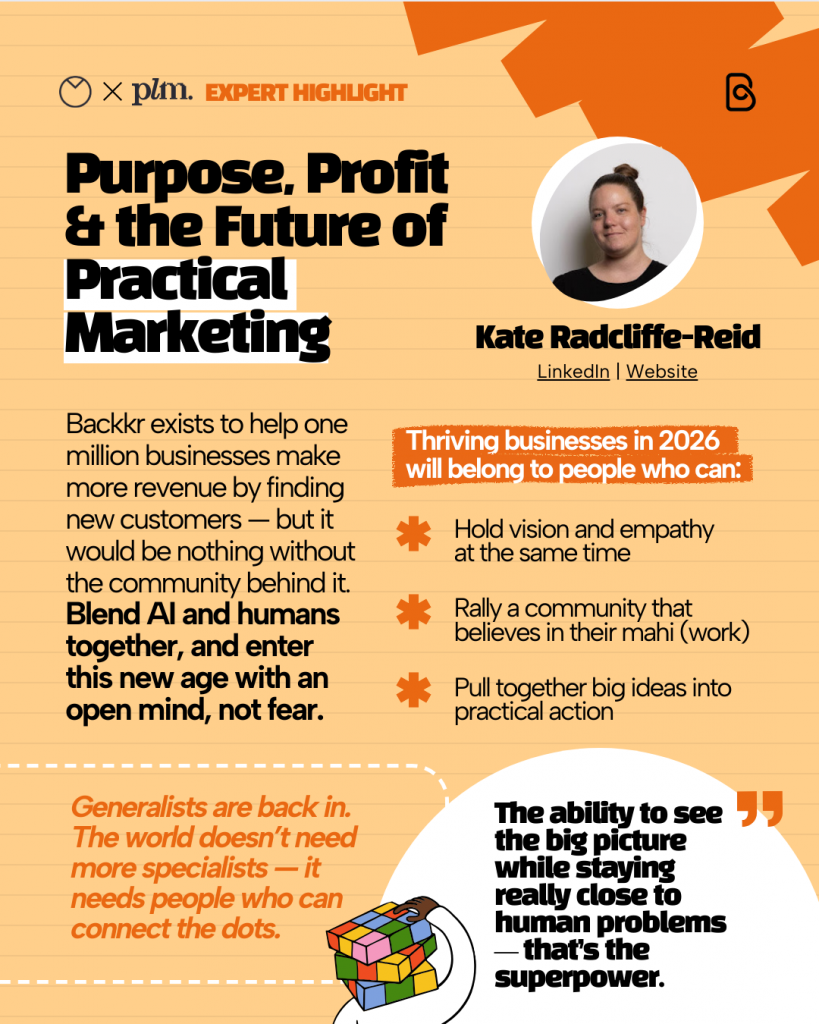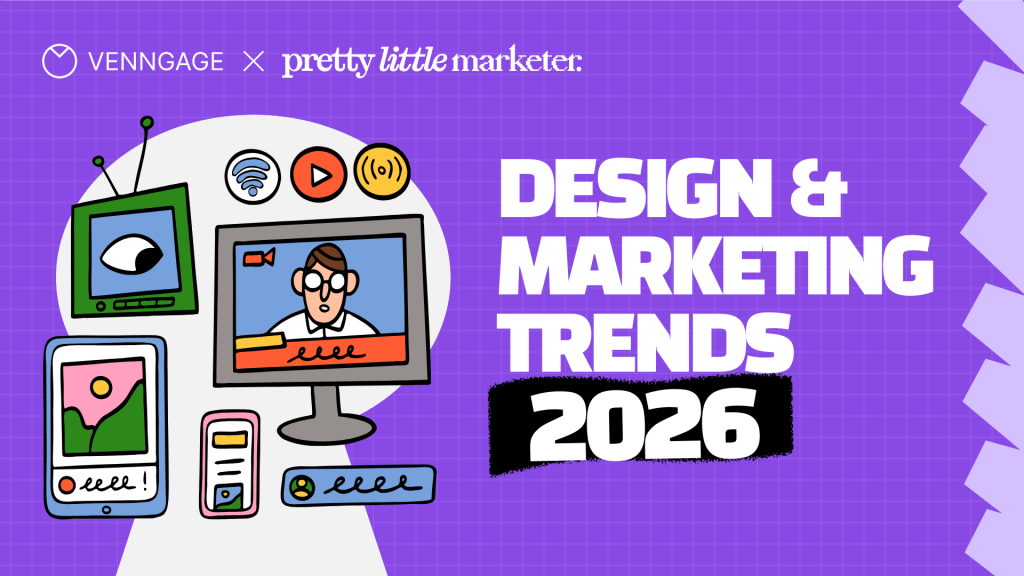
If you’re reading this, congratulations. You survived a year of shrinking budgets, AI experiments and constantly moving goalposts.
2025 felt like a whole marketing era in itself. Teams have been experimenting with AI, chasing aesthetics, trying new tools and workflows, and rewriting playbooks on the fly.
To make sense of what all this means for the year ahead, we ran a survey with marketers and designers across industries and spoke to practitioners who are already navigating these shifts. Their responses helped us understand where teams are actually headed.
Word has it that 2026 will treat marketers more kindly (fingers crossed). The focus is shifting from trying everything to making what works, work better.
2026 is going to be about integration, intelligence and intentionality. Marketers will take what they learned in 2025 and turn it into sustainable, strategic systems instead of one-off wins.
In this article, we’ll share the design and marketing trends shaping 2026 and what they mean for how you plan, design and ship work this year.
This is Part 2 of our Design and Marketing Trends series. If you missed Part 1 or want more context, start there for how 2025 trends reshaped AI, workflows and visual strategy.
Before we dive in, a huge thank you to the marketers and creators who generously shared their time and perspectives for this report. And a special shout-out to the Pretty Little Marketer (PLM) community for collaborating with us.
Here are the pretty little marketers who shared their insights on how marketing and design trends are shifting:
- Sophie Miller – Founder of PLM
- Grace Tranter – Digital PR Strategist
- Livi Matthews – Senior Brand Manager
- Katerina Stasiukevich – B2B Digital Marketer
- Helene Choo – Marketing Humanizer
- Michael Parker – Head of Marketing
- Laura Triana Africano – Social Media Strategist
- Tobias Svenlov – Marketing Strategist
- Nefise Tasdelen – Sales and Marketing Strategist
- Amy Learmonth – Marketing Manager
- Kate Radcliffe-Reid – CEO
- Tanya Howard – Strategy and Branding
- Amy Watts – B2B Marketer
- Ellie McGuigan – Paid Social Manager
- Masa Butara – Social Media Strategist
The 2025 recap
Before we look ahead, let’s do a quick recap.
In 2025, AI moved from an “interesting tool” to a real driver of performance. Almost half of marketers say AI integration had the biggest impact on their design and marketing results.
The picture is clear: speed and output are no longer the problem. Making that output actually clear, consistent and effective is the real challenge.
Key findings
1. AI integration became a real performance lever
48% of marketers say that AI integration had the biggest impact on design and performance in 2025.
2025 marketing and design trends proved that speed is easy; clarity is the new currency. AI can help you ship more content, and social platforms will always reward volume for a while, but volume without a clear story or structure is just noise.
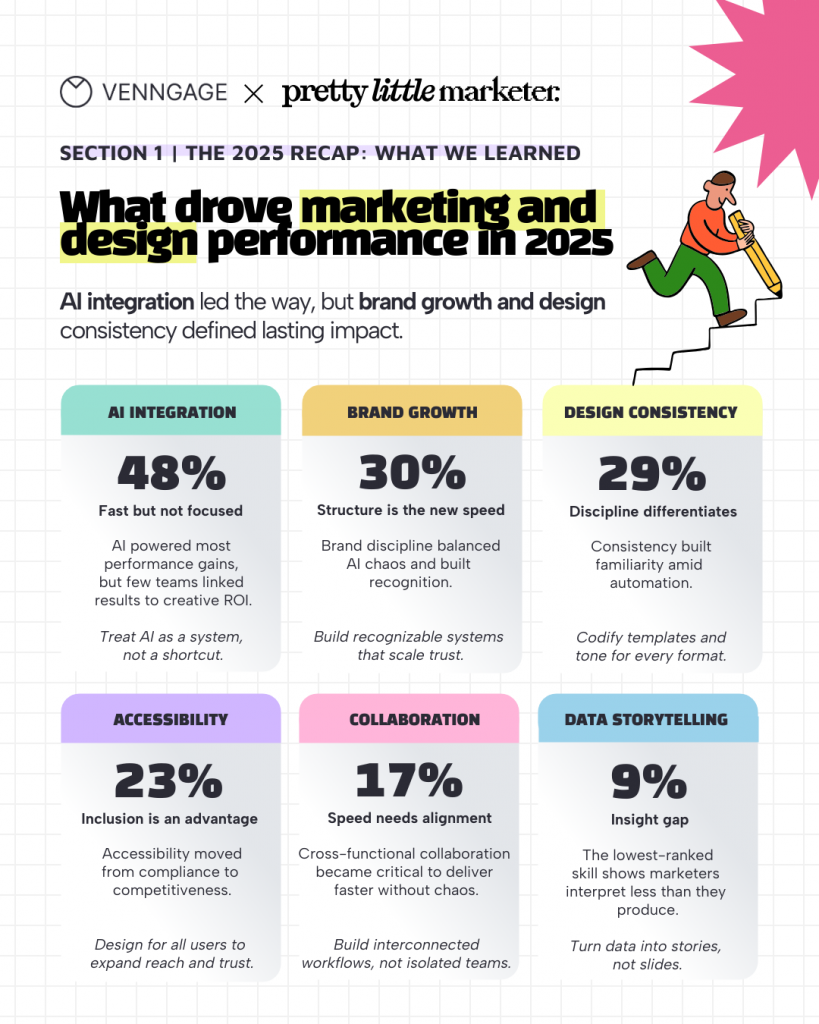
When we asked which platforms delivered the strongest results for marketing and design goals, this is how they stacked up:
- Instagram: 55%
- TikTok: 51%
- YouTube: 42%
- LinkedIn: 19%
- Threads: 10%
- Reddit: 8%
Instagram, TikTok and YouTube clearly emerged as the top performance drivers, showing that short-form, visual storytelling is still the most reliable path to engagement.
LinkedIn ranked as a thought-leadership hub, while Threads and Reddit remained in the “experimental” bucket for most teams.
What this means
AI is no longer a fun side project. Instead of asking “Are we using AI?” ask “Where does AI live in our process?” Plug it into what already exists: your brand guidelines, templates and approval flow. Treat it like another team member with a clear job, not a magic button you press at the end.
With Instagram, TikTok and YouTube leading performance, your brand story cannot live only in long posts and static PDFs. If it does, you are meeting your audience halfway at best. For every campaign or big idea, start by creating one hero visual asset, then spin it into short clips, carousels or simple animations that can actually move in the feed.
Michael Parker, Head of Marketing, explains, “AI has changed the pace of marketing, but speed isn’t strategy.”
To lead with strategy, Parker suggests reviewing all marketing assets through five lenses:
- Relevance: Does it serve our core audience?
- Potential: Is the commercial opportunity worth the space and effort?
- Positioning: Is it consistent with where the product sits; budget, high-performance, or problem-solver?
- Messaging: Does it clearly tell the customer what it is, what it’s for, and why they should buy it?
- Perception: Does it elevate the brand, or does it cheapen it?
AI and Automation
Most teams are using AI somewhere in their process, but only a small share have turned it into real infrastructure.
The data shows a clear pattern: AI is strongest in execution. It is helping with data visualization, content ideas, layouts, accessibility and design systems. Strategy, story, voice and judgment are still very much human work.
In other words, AI is already in the room. The real question for 2026 is not if you use it, but how deeply it is wired into your workflows and how well you protect your brand while you scale.
Key findings
1. Most teams use AI, but few have mastered it
In our survey, nearly 70% of marketers say they have integrated AI in some form, yet only 8% describe their setup as systemic.
The rest are split between experimental (29%), operational (38%) and integrated (21%) stages. This shows that most marketers are still in the “tool phase,” not yet in the “infrastructure phase.”
2. AI’s sweet spot: everyday execution
When we asked where AI shows up in workflows, the top use cases were:
- 38% use AI for data visualization and chart creation.
- 36% generate content ideas and use it for copy support.
- 35% have automated accessibility process and design system using AI
- 32% create mockups and previews.
AI is already part of the production backbone, handling repetitive tasks.
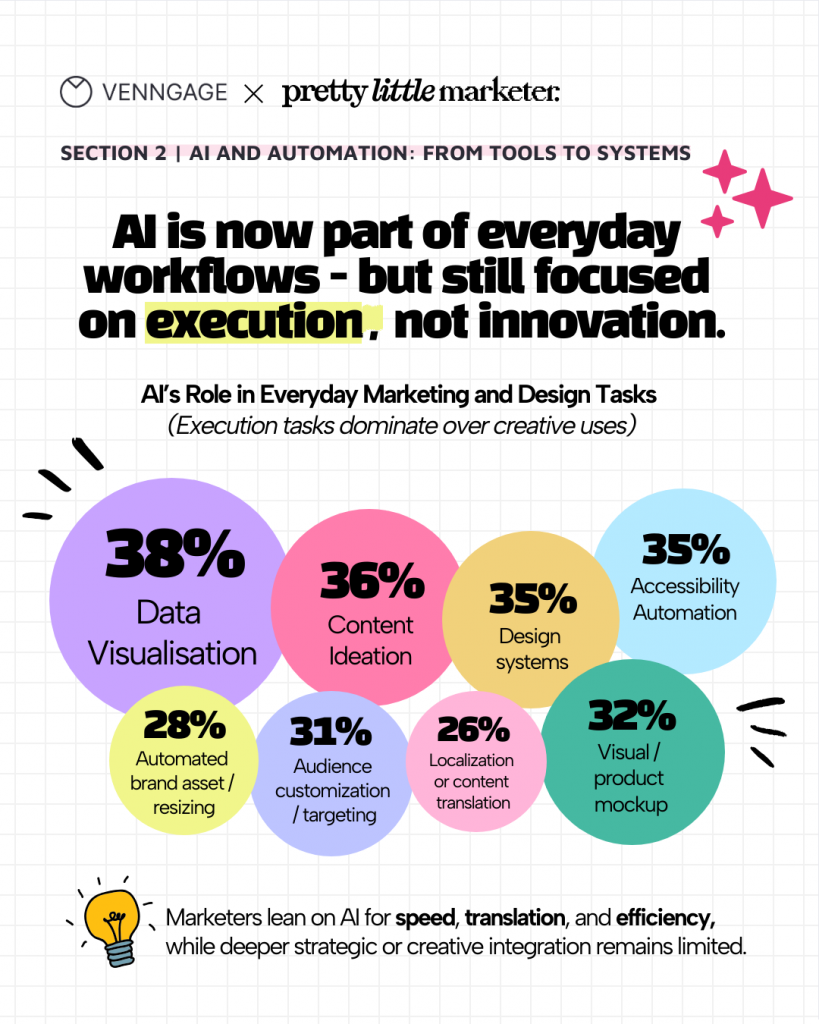
3. The biggest AI headaches are about brand and trust
While the teams are using AI for different tasks, marketers worry about their brand identity. Around 43% of marketers say their biggest headache is keeping AI outputs on-brand, followed by 37% who are still figuring out how to prompt it properly.
Another 36% worry about the quality of what AI produces, and 31% simply do not trust it yet. So the problem is less “Can AI do this?” and more “Will it do this in a way we are happy to put our logo on?”
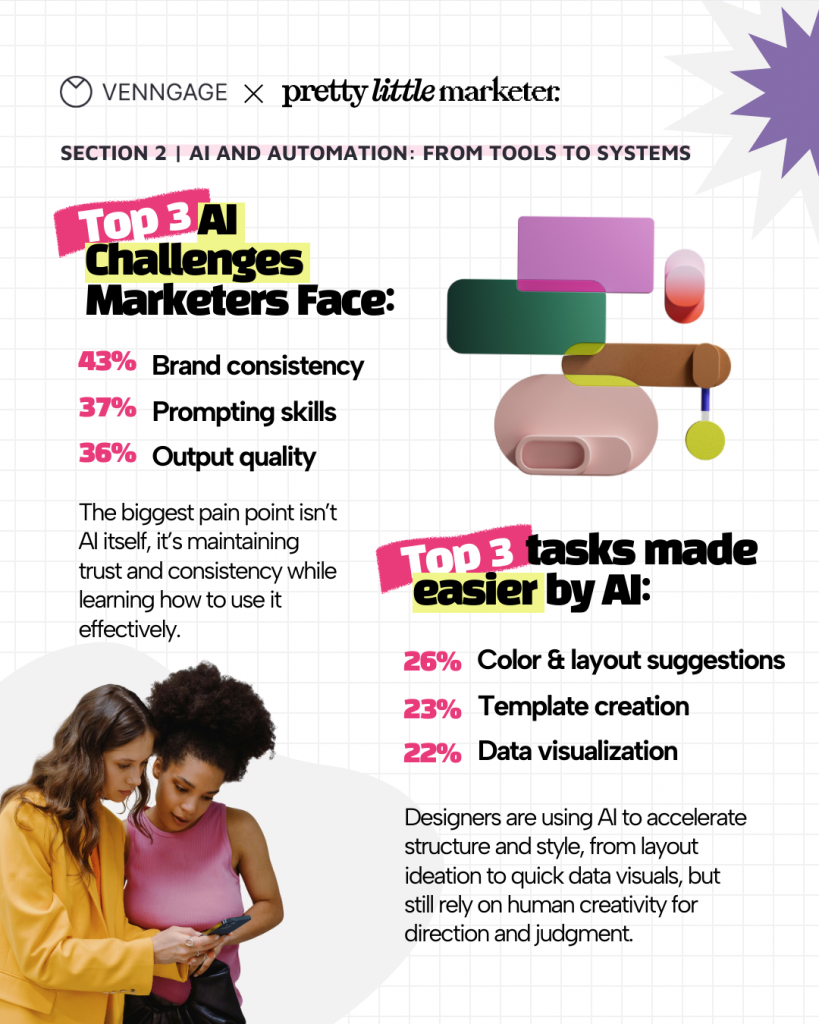
4. What marketers want to automate next
Looking ahead to 2026, teams want AI to help with:
- 44% of marketers want to use AI for more idea and marketing prompt generation.
- 42% will use AI for brand consistency and templates
- 37% will likely use AI for layout design and resizing visuals
- 32% want to use AI for accessibility checks
This shows a shift from automating only creation to automating consistency and compliance. Marketers want AI that keeps them fast and on-brand simultaneously.
5. Where humans stay in charge
Marketers are clear about what still needs a human touch:
- Brand tone and identity: 40%
- Emotional storytelling: 38%
- Campaign strategy: 35%
- Sensitive or high-stakes content: 34%
- Ethical or cultural sensitivity decisions: 31%
Judgment, nuance and meaning remain human domains.
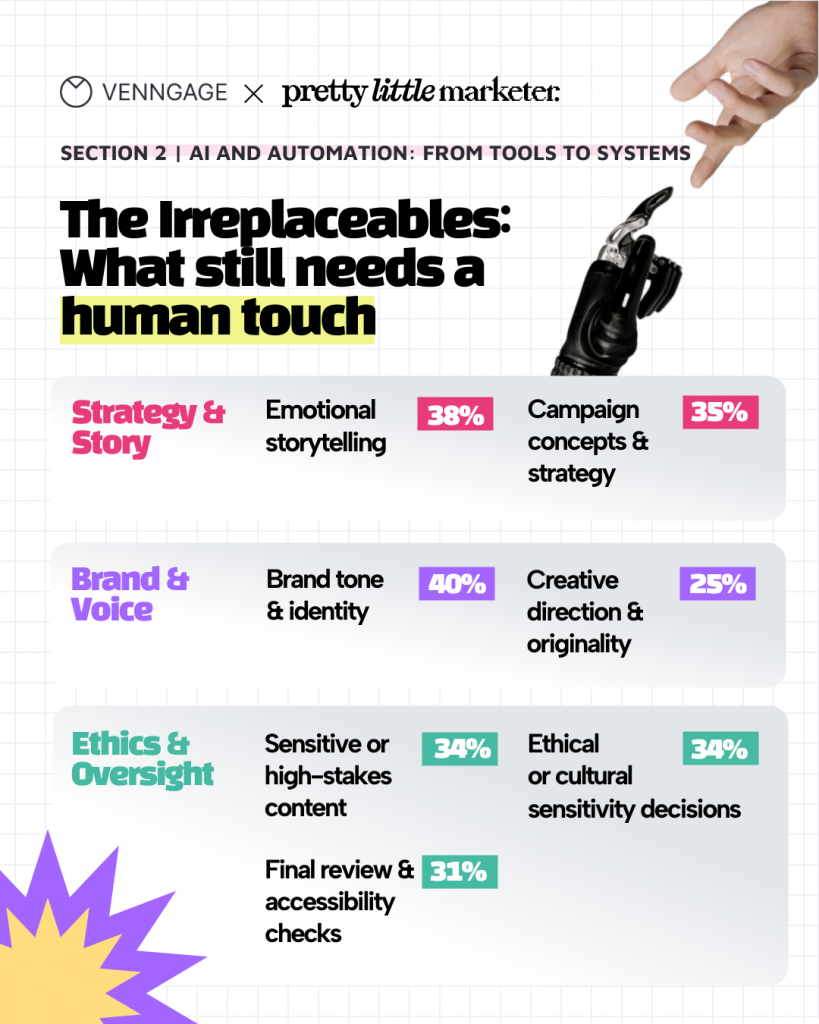
6. Designers use AI for structure, not direction
For design, the top tasks made easier by AI are:
- Color and layout suggestions: 26%
- Template creation: 23%
- Data visualization: 22%
Assistive work is already offloaded. The bigger creative calls still sit with designers.
What this means
As teams pile on more tools and AI platforms, staying on-brand gets harder. Every new template or AI-generated visual adds a bit of risk. Small tweaks to color, type or layout feel harmless on their own, but together they turn into a brand that looks slightly different in every place.
If you are scaling creation with AI, governance needs to be a part of the growth plan. 2026 will reward brands that bake consistency into the system: clear rules, locked templates and simple checks that run in the background. The goal is to let AI help you move faster, without quietly shifting from the identity you have spent years building.
Along with brand consistency, it’s also important to make your brand discoverable across multiple touch points. Choose a set of primary channels, use the same visuals and handles everywhere and treat each search surface as a credibility checkpoint, not just a distribution slot.
As Ellie McGuigan, a paid social manager, puts it, “To rethink trust-building, brands need to become part of the conversation. Users are searching and verifying across multiple platforms, so brands should establish discoverable touchpoints like TikTok, Reddit and YouTube, and test emerging ad placements like Pinterest search ads. This presence signals legitimacy and meets users in their natural verification journeys.”
Plus, your brand needs to feel more human as AI takes up a lot of execution part.
Sophie Miller, Founder of PLM, explains that to add human touch to the brand, make sure you know ‘who you are,’ ‘what you stand for,’ and ‘what you sound like.’
“For brands trying to keep their human touch in 2026, the work is the same as it’s always been: get clear on what makes you recognisably you. What’s your take? What do you care about? How do you show up? Once you know that, AI becomes a lot less threatening because you’re not asking it to be you, you’re just asking it to help you do what you already do.”
Sophie Miller, Founder of PLM
Social media strategy: Where to focus and what to post
Social is shifting from ‘everywhere’ to ‘effective.’ Our data shows marketers are concentrating on a few visual-first platforms, building a content mix that teaches, entertains and showcases the product. Many are also relying on short video, motion formats and carousels that can be reused across channels.
At the same time, they are pruning underperforming networks, pushing back on copy-paste trends and influencer fatigue and putting clearer guardrails around AI-generated visual content, so reach does not come at the cost of trust.
Key findings
1. Visual-first, video-led platforms form the core stack
When we asked marketers which platforms they will prioritize in 2026, these stood out:
- Instagram: 50%
- TikTok: 42%
- YouTube: 32%
Instagram, TikTok and YouTube carry most of the performance weight, powered by short-form, visual storytelling.
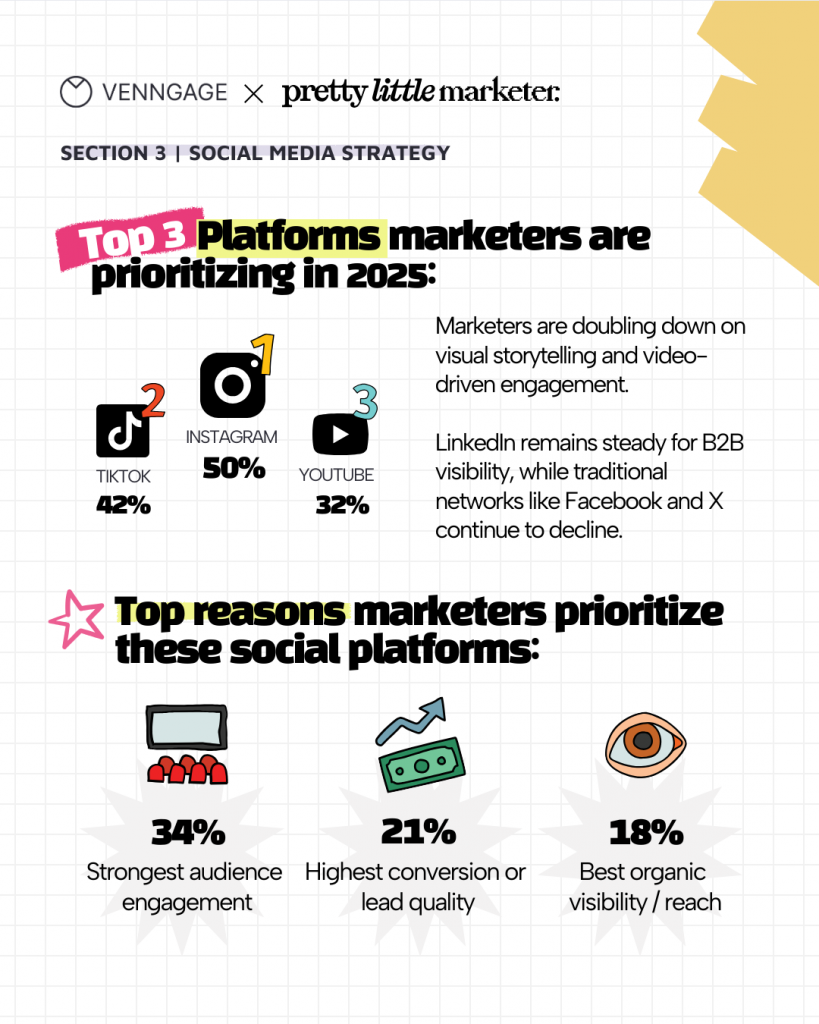
2. The 2026 content mix blends utility, personality and product clarity
When we asked what marketers plan to publish more of, here’s what they said:
- 34% plan to publish more educational or how-to content
- 31% will focus on entertaining or humor-driven content
- 29% will prioritize product or feature-focused content
- 25% are looking to publish more thought leadership content
Together, these points point to a clear pattern. Content that teaches, feels human and makes the product easier to understand will define most social calendars in 2026.
3. Motion and modular storytelling are shaping visual strategy
On the visual side, teams are rallying around a small set of formats:
- Short-form video under 60 seconds: 46%
- Motion graphics or animations: 30%
- Carousels: 27%
Short clips, lightweight motion and multi-frame posts fit the way people now scroll, save and share. Static visuals are not disappearing. They are being redesigned into modular assets that can carry a story across multiple posts and platforms.
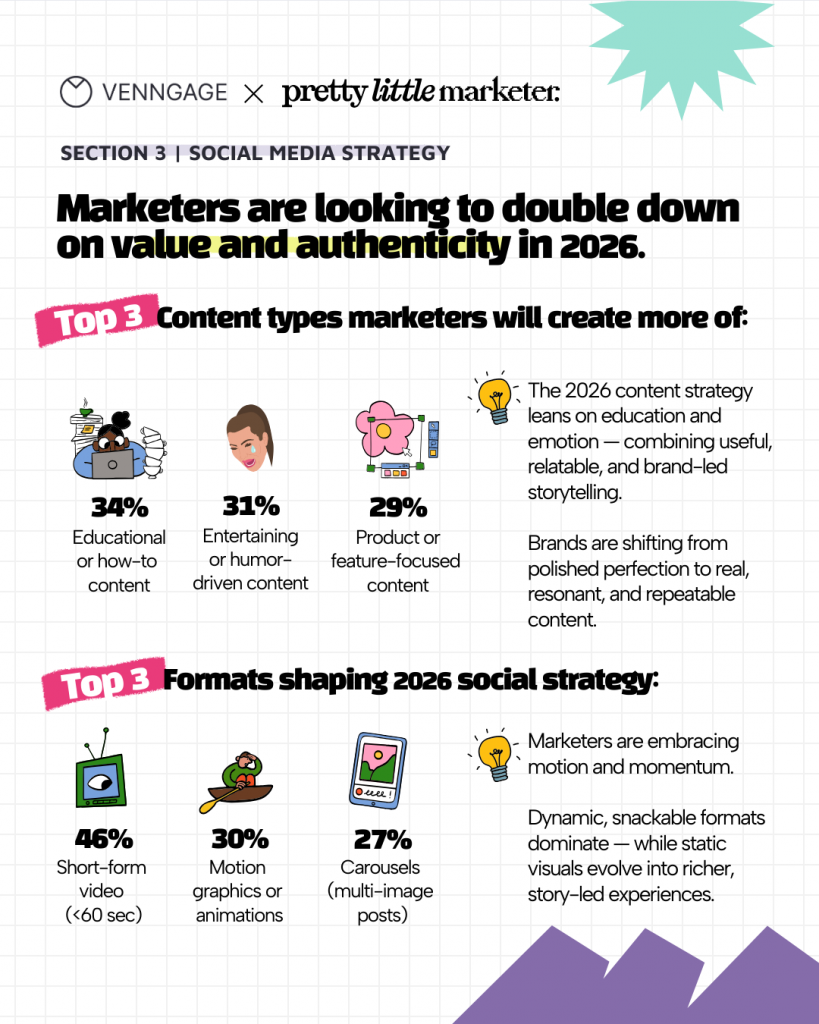
4. Marketers are tired of copy-paste trends and are worried about trust
The most overrated trends, according to marketers, are:
- TikTok-style content everywhere: 40%
- Heavy influencer collaborations: 34%
- Overdone LinkedIn “thought leadership”: 28%
This fatigue shows up alongside deeper concerns about AI visuals. Authenticity and human connection (40%), accuracy (36%) and copyright and ethics (27%) are bigger worries than speed.
Teams are less interested in chasing whatever worked for someone else and more focused on content that feels credible, context-aware and safe to put the brand behind.
What this means
In 2026, social media strategy will be about building a clear, visual strategy. Marketers will use Instagram, TikTok and YouTube as the main stage for their story and use LinkedIn to reinforce expertise and trust.
As Tobias Svenlöv, a marketing strategist, puts it, “People are tired of performing, competing, losing their jobs and being lied to. They want to live in a world that is more authentic and real, supporting brands that match that vibe. We will see smaller brands gain ground as bigger brands struggle to connect with the new lingo.”
You’d need to:
- Build a repeatable content mix that teaches, entertains and shows your product in action, instead of relying on trends to carry you.
- Design a motion-first visual system with templates for short videos, carousels and infographics that can be adapted across platforms without losing your brand.
- Put light but clear guardrails around AI-assisted visuals so they stay accurate, ethical and recognizable as yours.
Laura Triana Africano, a social media strategist, recommends talking clearly about your methodology, your expertise, and the problems you solve so your audience can understand why you matter.
To perform better on social media, Maša Butara, a social media strategist, suggests focusing on community, connection and slower, more meaningful growth.
“Real growth happens in the moments between posts when you reply to messages, join conversations, and engage with your community. Small actions like these build loyalty faster than any perfectly edited post.”
Maša Butara, Social Media Strategist
Visual intelligence: Aesthetics, formats and fatigue
The visual story is shifting. After a run of hyper-digital, overproduced aesthetics, audiences are gravitating toward visuals that feel more tactile, narratively rich and recognizably human, even when AI is in the mix.
Marketers are not just asking “what looks good” anymore. They are asking “what feels honest, what fits our brand system and what the data can actually defend.”
1. Top aesthetics on the rise
- 59% are leaning into AI comic or illustrated storytelling that turns complex ideas into simple, narrative frames.
- 54% are experimenting with human + AI hybrid photography to keep real-world texture while adding subtle AI enhancements.
- 39% are exploring real-paper textured illustration so digital assets feel more physical, crafted and layered.
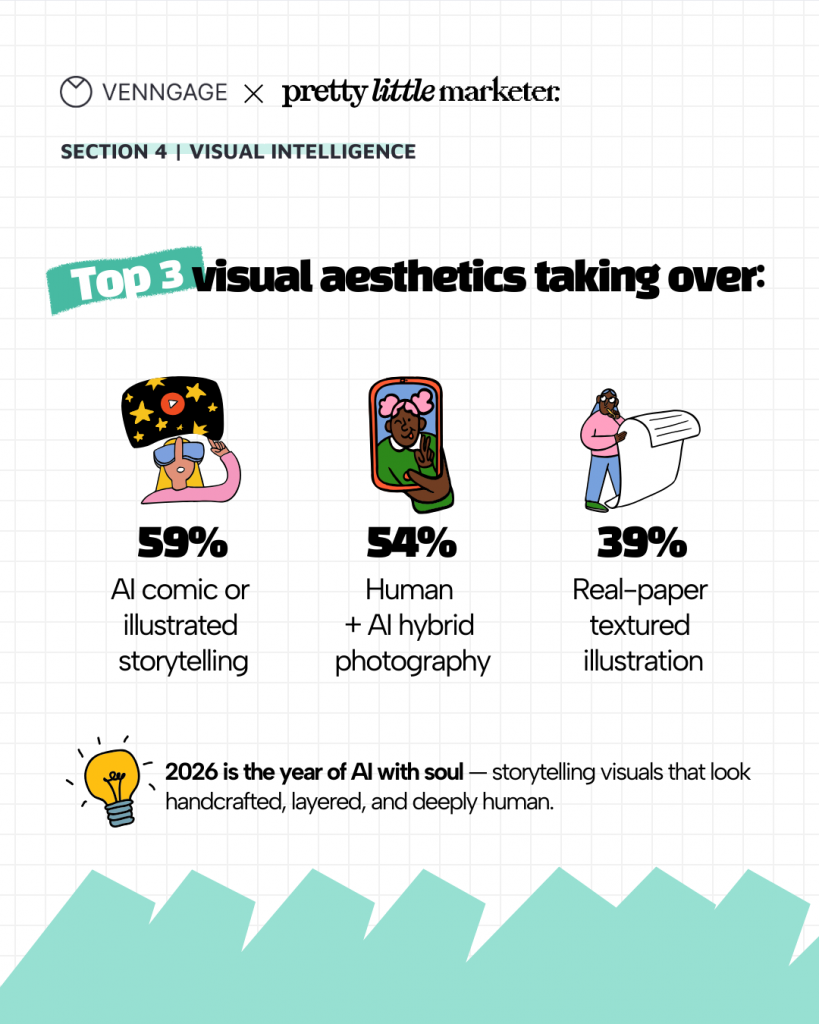
2. Aesthetics marketers are moving away from
At the same time, there is clear fatigue with the aesthetics that dominated the last few years. About 44% of marketers say unrealistic 3D renders now feel overused. More than a third feel the same about trend-bait gradients and overly polished AI portraits.
What once looked futuristic now blends into a generic “AI look.”
3. Tone shifts: more real, more branded, more story-led
Tone is changing alongside aesthetics. The goal is not just to look different, but to feel different.
- 30% are aiming for more authentic visuals that feel closer to real workflows, customers and behind-the-scenes moments.
- 29% want visuals to be more branded and systemized so everything still sits inside a recognizable visual language.
- 19% are pushing for a more editorial or story-driven tone that unfolds ideas over a series, not a single post.
This is not a swing to raw, unfiltered content. It is a blend of real-life context, consistent brand systems and clearer narrative structure.
4. Factors shaping visual choices
Design decisions are becoming more disciplined. Instinct is still there, but it now sits alongside brand rules and data.
- 33% of marketers put brand consistency and identity at the center of design decisions, using systems and guidelines as the first filter.
- 32% say performance and engagement data guide their choices, watching what actually earns clicks, saves, and shares.
- 29% rely on audience insights and feedback to refine aesthetics and tone over time.
Visual branding is shifting from taste-driven to strategy-driven. Brand clarity and performance are guiding the art, helping teams decide which aesthetics to scale and which to retire.
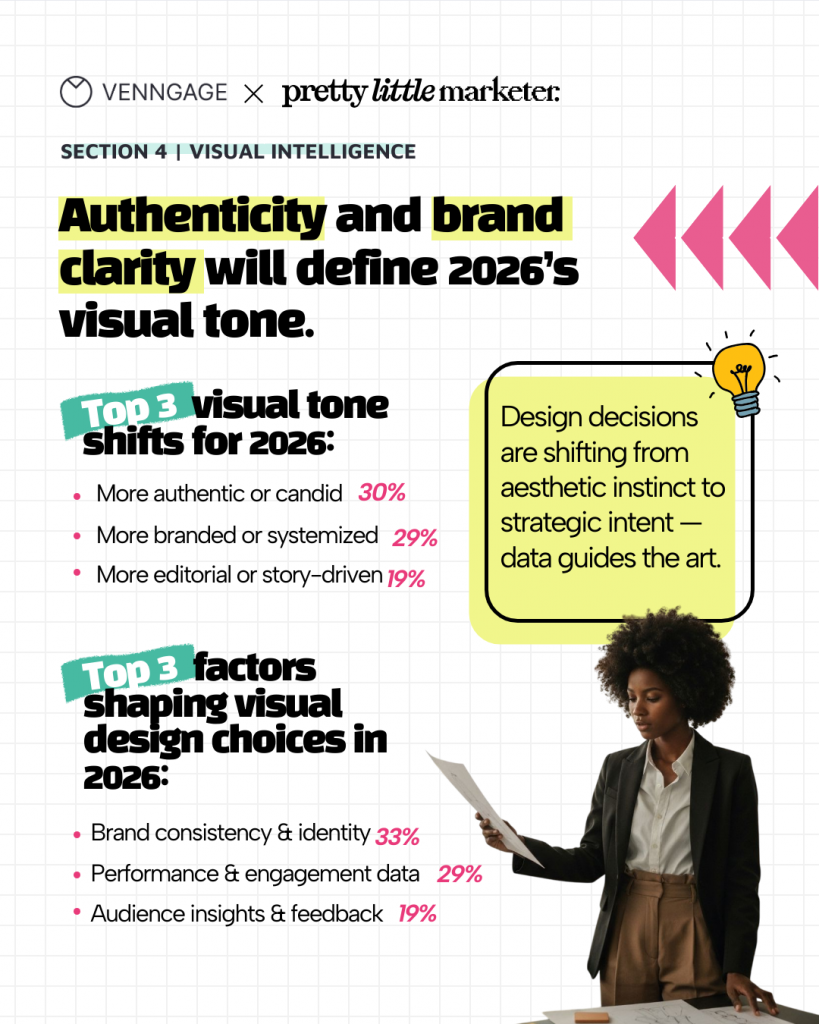
What this means
Visual decisions are moving out of the “nice to have” zone and into the core of brand strategy. The aesthetic you choose is no longer just a style choice, but depicts trust and performance.
“Good design will be human. Language will be the biggest design differentiator. Design quality, creativity and impact will suffer as technical skills keep getting prioritized over creative depth. We will see a clash between big brands using too much AI and customers boycotting them for it. People are tired of performing, competing, losing their jobs and being lied to.
They want to live in a world that is more authentic and real, supporting brands that match that vibe. We will see smaller brands gain ground as bigger brands struggle to connect with the new lingo.”
Tobias Svenlöv, Marketing Strategist
Here’s how you can frame brand aesthetics:
- Center your visuals on story, not just style: Use AI comic frames, hybrid photography or textured illustration to clarify a narrative or idea, not just to look current. Every key asset should answer a simple question: What is the story this visual helps someone remember?
- Refresh your brand system for new aesthetics: If you are leaning into more candid or editorial visuals, update your brand kit and templates to match. Define how “authentic” looks in your context, which illustration styles are in bounds and how texture or grain should be used.
Amy Watts, a B2B marketer, explains that many B2B brands hesitate to be creative because they think that it involves memes or unhinged PR stunts.
“You can still create engaging content in a “serious” industry. Sometimes it’s as simple as changing the format: instead of another data-heavy case study, tell the story of how someone achieved their goals with your product. Stop focusing on what your industry expects, and start thinking about what your audience actually wants: content that they can relate to.”
Amy Watts, B2B Marketer
Workflows & collaboration: How work gets done now
AI is speeding things up, but only for teams with solid systems. More than half of teams plan to put AI-assisted creation at the center of how they design, but the ones seeing the biggest gains are also doing two other things: using data to shape stories and building accessibility into their process.
In practice, that means designers and marketers are shifting from one-off ‘hero’ projects to shared systems: templates, checks and collaboration rules that keep work fast, on-brand and usable for more people.
Key findings
1. Priority design approaches for 2026
When we asked which design approaches teams will prioritize next, three patterns stood out.
- 54% will prioritize AI-assisted creation as a core part of their design workflow, not just a backup option.
- 38% plan to focus on data-driven storytelling, so key visuals are anchored in real performance and audience insight.
- 36% will emphasize accessible design practices as a standard.
AI is clearly shaping how work gets done, but it is not acting alone. It will be embedded into systems that are guided by data, accessibility and brand rules.
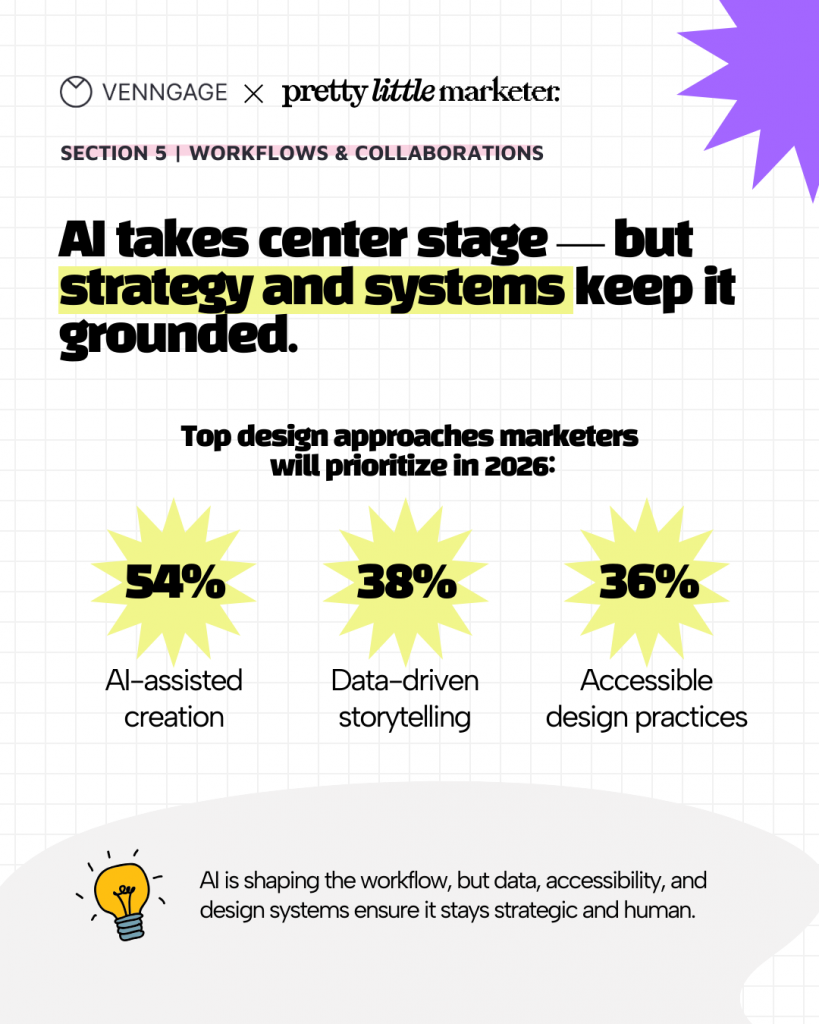
2. Accessibility is becoming a core priority
Accessibility is no longer just a checkbox at the end of a project. It is becoming part of how teams define “done.”
How teams think about accessibility today
- 59% say accessibility is a growing focus in their design process and getting more attention over time.
- 11% still report low or no focus on accessibility in their workflows.
Taken together, that means nearly nine in ten marketers now see accessibility as a core or expanding part of their process. This signals a shift away from bare-minimum compliance toward a more intentional approach to inclusion and usability.
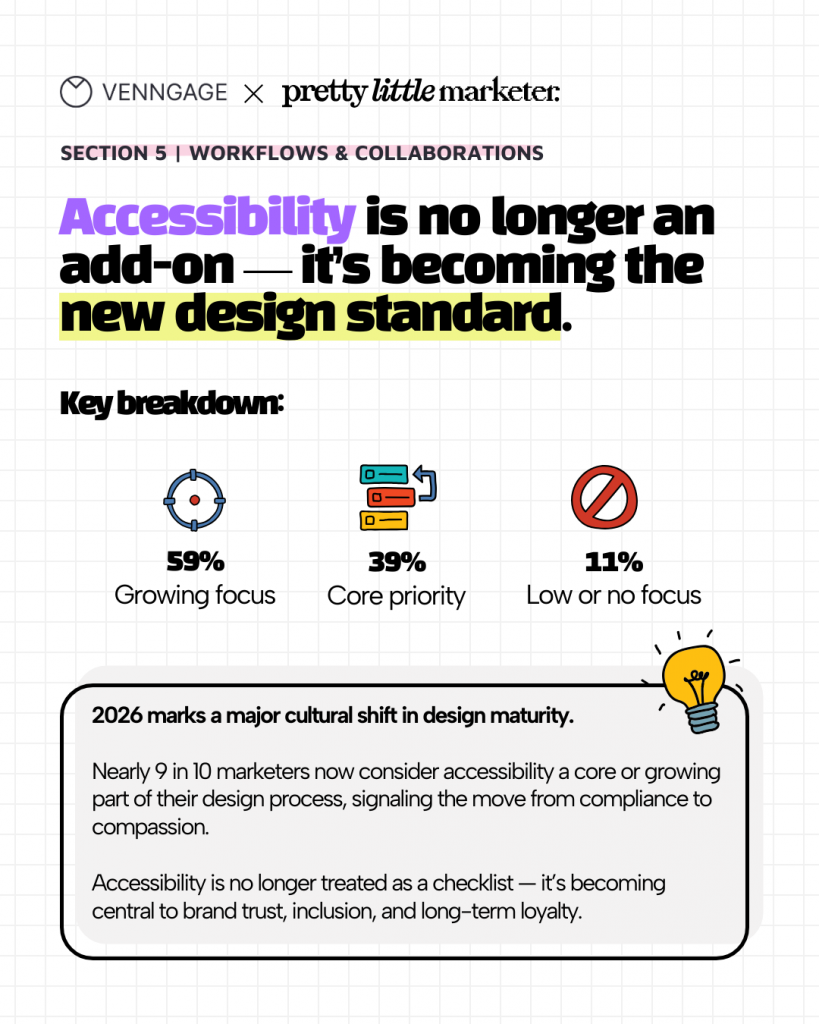
3. Knowledge is the biggest barrier to accessibility
Most teams say they care about accessible designs. The problem is turning that intention into daily practice.
- 27% point to insufficient training as the main reason accessibility is not consistently implemented.
- 18% say a lack of resources holds them back, from dedicated experts to proper tooling.
- 15% cite limited time as the biggest constraint, especially when deadlines are tight.
The biggest blocker is readiness. Without clear ownership, training and practical tools, accessibility stays abstract and falls to the bottom of the to-do list.
What this means
Workflows are becoming the real competitive advantage. The teams that will move fastest and safest are the ones that treat AI, accessibility and collaboration as parts of the same system, not separate projects.
A few practical implications:
- Give AI a defined role in the process: Decide where AI assists (ideas, layouts, resizing, charts) and where humans lead (strategy, tone, ethics). Document this so designers and marketers know when to reach for which tool.
- Bake accessibility into templates, not just reviews: Instead of fixing issues at the end, build accessible defaults into your brand kit and templates: color contrast, type hierarchy, alt-text prompts and export checks.
- Align designers and marketers around shared systems: Use the same templates, naming conventions and review criteria for easy collaboration.
Helene Choo, a marketing humanizer, says. “To set up systems that increase our efficiency without hollowing out our message, create a balanced workflow, which builds emotion into automation.”
Choo shares a balanced workflow to keep “empathy at the centre while letting AI do what it does best”
- Insight Phase: Let AI find patterns, humans decode the ‘why’. Use AI to scan audience data (social, CRM, heatmaps), then run a short “human read” to map the real emotional drivers behind what you see.
- Ideation Phase: Co-create with AI. Let AI draft concepts or outlines, then workshop them: Does this sound like our audience? Does it feel like a real person, not a pitch?
- Creation Phase: Add emotion checkpoints. Build quick checks into your workflow:
- Tone: Does this sound human, not like a brand bot?
- Empathy: Would this feel respectful to the person reading?
- Clarity: Is the point obvious on a first read?
- Delivery Phase: Automate the “when,” not the “voice.” Use automation for timing and distribution, but keep humans in charge of what you say and how you say it.
- Review Phase: Measure numbers and feelings. In retros, ask: What worked in the data? What felt right or off? Pair performance metrics with quick internal reflections or audience polls on how the content landed.
Ellie McGuigan recommends shifting your mindset to “test less, learn more” in 2026 to move faster.
“Start by asking sharper questions like: ‘How does our approach to Advantage and Smart campaigns impact performance?’ or ‘Does our audience actually respond to XYZ?’ Make sure every question ties back to a concrete business goal.
Then, instead of running random ad-hoc tests, build a year-long testing plan where every experiment is designed to answer those questions. Give each test room to breathe — at least four weeks to fully learn — and leave time to review the results properly before you move on to the next one.”
Ellie McGuigan, Paid Social Manager
Measurement evolution: Redefining success
We are moving beyond vanity metrics. Engagement rate and conversion rate now outrank reach, CTR or content speed, and new metrics like SEO and LLM visibility, brand consistency and accessibility are starting to show up alongside them.
This pulls AI into the same performance conversations as the rest of the work instead of treating it as a separate efficiency experiment.
In this section, we look at how marketers are redefining success, what they expect AI to prove, and which new metrics are starting to matter.
Key findings
1. The shift to meaningful outcomes
Marketers are prioritizing engagement and conversions over impressions, volume and speed. Teams are done chasing numbers that do not connect to outcomes.
- 56% put engagement rate at the top of their measurement priorities, using it as a signal of whether content is actually landing with the right people.
- 52% prioritize conversion rate as a core success metric, tying creative and content directly to sign-ups, leads or revenue.
Lower-priority metrics tell a clear story about what is fading:
- 29% still focus on click-through rate, and
- 24% prioritize reach,
- 9% care about content production speed as a key metric.
Volume and visibility still matter, but they no longer define success on their own.
Emerging priorities point to a broader mindset shift:
- 22% are focusing on SEO and LLM visibility, aiming to be found in both traditional search and AI-generated answers.
- 21% are tracking brand consistency, and
- 14% are tracking accessibility, turning quality and inclusion into measurable standards rather than soft goals.
Taken together, this shows that teams are optimizing for resonance, not output. They want content that starts conversations, drives actions and shows up reliably in both human and AI discovery.
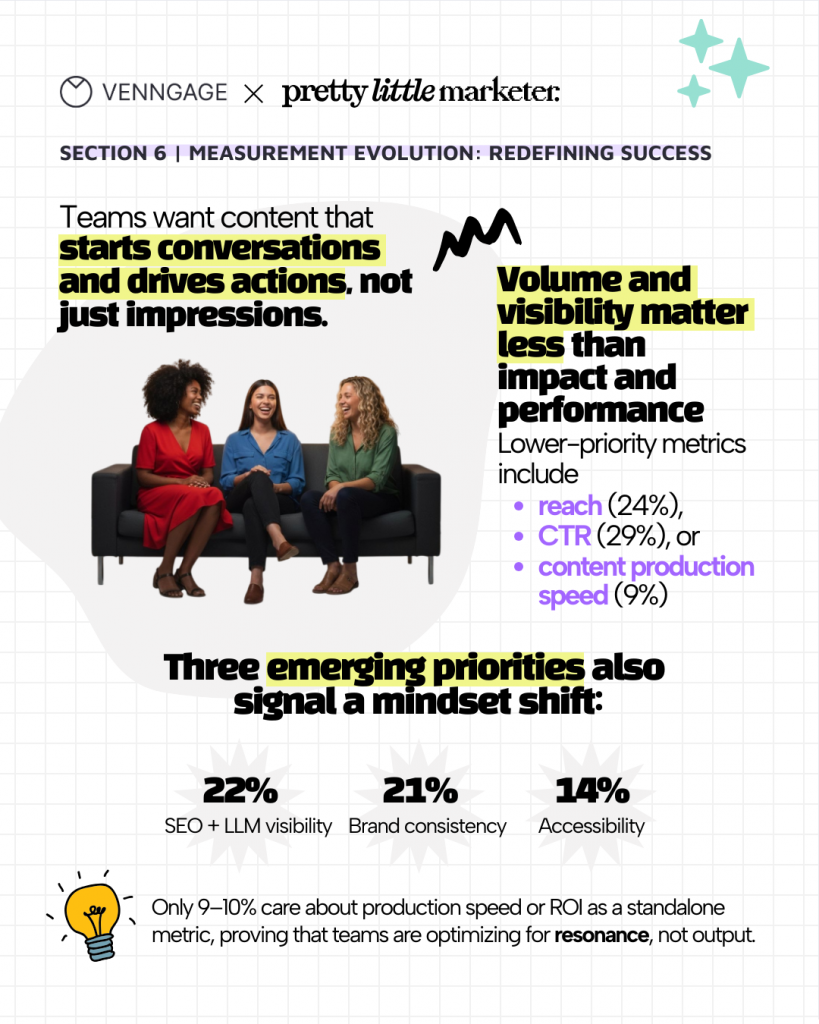
2. Teams want AI to prove value, not just speed
For teams that are tracking AI impact, performance is the benchmark, not just efficiency.
- 36% say engagement or conversion performance is the most valuable way to measure AI, using downstream results to judge whether AI is helping or hurting.
- 22% focus on time saved,
- 16% look at output volume, and
- 14% track cost reduction as supporting metrics rather than the main headline.
There is also a clear move toward more structured AI measurement:
- 10% plan to start measuring AI impact in 2026, which signals growing maturity around how AI is evaluated.
- Only 3% have no interest in tracking AI at all, meaning almost everyone agrees that AI needs to be measured, not just used.
The pattern is consistent: AI is no longer being judged only on how fast it works, but on whether it actually drives results that matter to the business.
What this means for marketers
Measurement is becoming a strategy exercise, not just a reporting habit. Scorecards need to reflect what actually moves the brand and the business, across both search and social.
As Katerina Stasiukevich, a B2B digital marketer, points out, more answers are now being served inside social apps and AI assistants instead of sending people to your website. That shift is already driving more zero-click behaviour and new referral patterns, so being referenceable now matters as much as ranking.
A few practical implications:
- Rebuild your core scorecard around outcomes, not outputs. Put engagement rate, conversion rate and a small set of business-linked metrics at the centre. Treat reach, CTR and production speed as context, not the headline.
- Add SEO, social search and LLM visibility to your reporting stack. Track where your content and visuals show up in search results, AI overviews and social discovery (profile searches, saves, shares). Make “findability” a measurable outcome alongside clicks and leads.
- Treat social content like mini landing pages. Use clear first-line keywords, descriptive captions, alt text and captions for video so both people and machines can understand what the content is about at a glance.
- Update your KPIs for depth, not just volume. Look at AI citations or chatbot mentions, conversation depth in comments, saves over likes, and conversions from social-sourced sessions (using UTM links and focused landing pages).
- Make brand consistency and accessibility measurable. Include simple checks or scores for brand alignment and accessibility in your regular reviews. If it matters to trust and inclusion, it should show up in how you report success.
Livi Mathews, a senior brand manager, puts it simply: “A successful marketer will be able to demonstrate how well they know their audiences, with clarity and confidence.“
Amy Learmonth, a marketing manager, also points out that some of the strongest signals never show up in dashboards. When a customer calls after seeing a Facebook ad, mentions they enjoy following your journey, or says a post helped them solve a problem, those offline moments are proof your content is working and should sit alongside the metrics you track.
Grace Tranter, a Digital PR Strategist, notes that traditional KPIs like backlinks and volume still matter, but they’re no longer the whole story.
“I think we’ll see a bigger shift towards measuring relevancy, authority and trust. Ask yourself: who’s mentioning your client, why, and in what context? Those signals, the words, the framing and the credibility of the outlet, are what’s going to matter most.”
Grace Tranter, Digital PR Strategist
The 2026 action framework: What to double down on
When teams sit down to plan 2026, the questions are pretty simple: Where do we put more energy, what needs fixing, and what can wait? The data points to four clear moves: sharpen how your brand shows up (social approach, design systems, positioning), decide where AI will be “always on” in your stack, upgrade the skills that make those systems work, and clean up distribution and measurement so good work actually performs.
This section pulls those threads together into practical priorities: what to double down on, what to evolve, and what is safe to leave in maintenance mode for now.
1. Where brands will invest most in 2026
Brands are heading into 2026 with a tighter focus on how they show up and where they put their energy.
Where teams are concentrating their efforts
- 42% are prioritizing their social media approach so it fits faster, more visual, algorithm-driven platforms instead of trying to force old formats into new feeds.
- 41% are investing in visual identity and design systems to keep the brand clear and consistent across every touchpoint.
- 37% are refining brand positioning and content formats so what the brand says and how it is expressed actually line up.
Under the surface, teams are also strengthening the foundations that support this:
- 28% are focusing on website and SEO improvements,
- 25% are upgrading AI and automation workflows, and
- 17% are evolving performance measurement.
Areas that sit lower on the list show where teams are not putting most of their energy right now:
- 13% are prioritizing accessibility,
- 8% are focused on campaign distribution, and
- 6% are rethinking team structure.
Overall, the pattern is clear: 2026 looks like a year of brand sharpening and strategic refinement, not full reinvention.
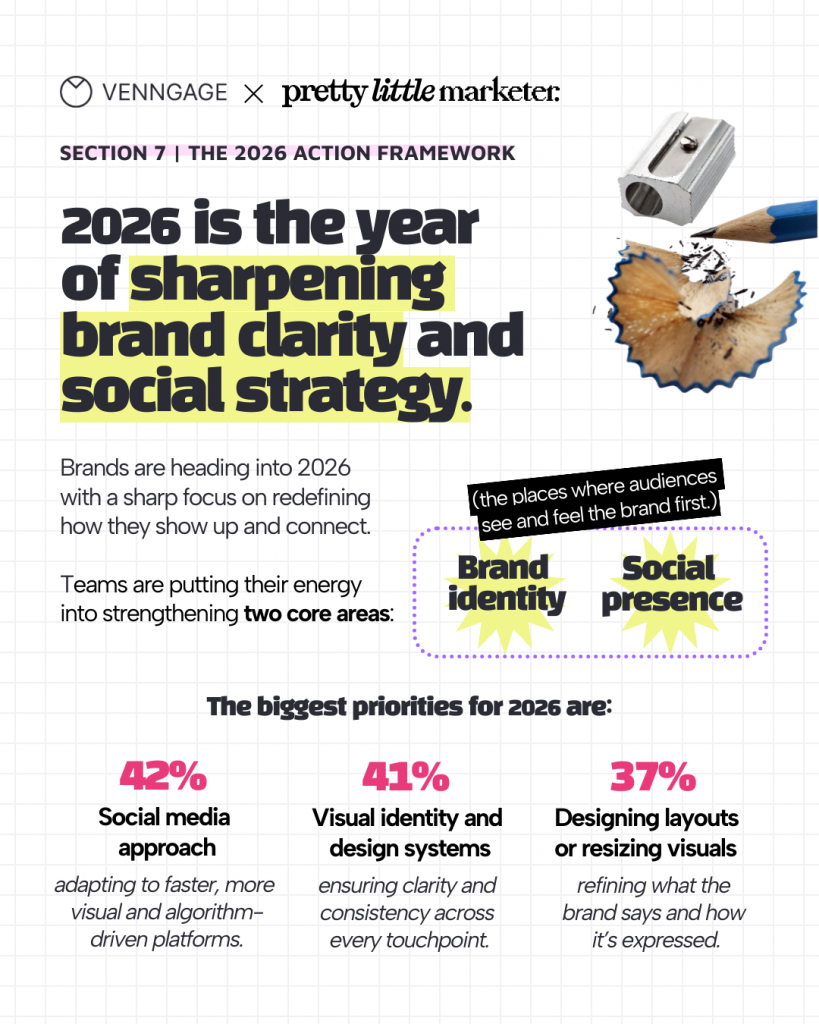
2. How marketers expect AI to reshape their work
When people describe the biggest shift they expect in 2026, the dominant theme is AI taking a more central role.
Common phrases from respondents include:
- “AI-driven experiences”
- “AI + automation workflows”
- “AI-driven hyper-personalization”
- “AI will drive marketing, not assist it”
Taken together, these point to a shared expectation:
- AI moves from assistant to engine, powering creativity, content, design, personalization and automation.
- AI becomes the default layer in the stack, not the “extra” tool you bring in at the end.
3. The skills teams are hiring and training for
2026 will reward marketers and designers who can combine human creativity with AI fluency and responsible judgment.
Top skills people expect to matter most
- 45% highlight creative originality and strategic thinking as the most important skill, keeping ideas and decisions differentiated.
- 39% point to AI prompting and workflow design as critical, so people can actually operationalize AI instead of just “trying tools.”
- 38% emphasize ethical and responsible AI use, reflecting growing focus on trust, governance and risk.
Supporting skills are rising too:
- 26% call out data storytelling,
- 15% mention accessibility awareness, and
- 14% value cross-disciplinary collaboration.
Adaptability sits at just 7%, which suggests success in 2026 is less about chasing every new tool and more about mastering fundamentals that can scale.
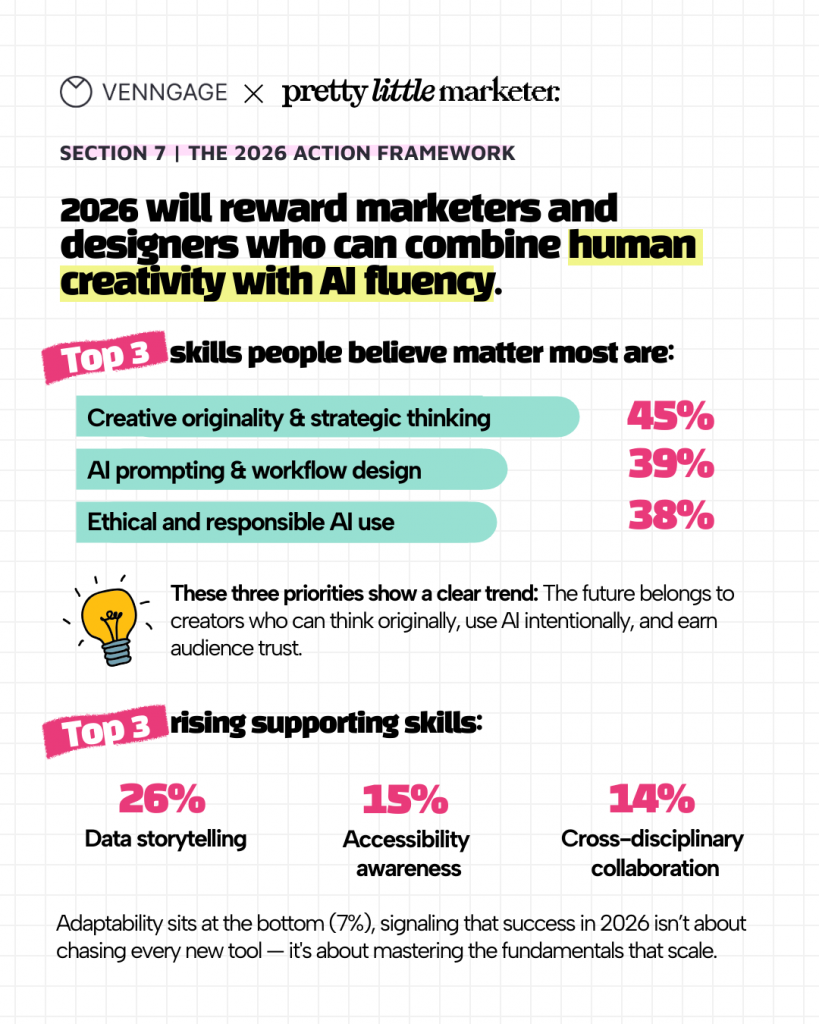
4. The systems marketers most want to fix next
When we asked what teams want to evolve next, the focus landed on systems and alignment rather than raw volume.
Biggest areas teams want to evolve
- 43% want to improve content distribution, making sure good work actually reaches the right people.
- 40% want to evolve AI visual aesthetics so outputs look more branded and less generic.
- 38% want to improve success metrics, shifting from vanity numbers to value-focused measurement.
- 36% want to level up team collaboration, so designers, marketers and other stakeholders work from shared systems instead of disconnected files.
Other priorities reinforce the same theme:
- 32% are rethinking social platform focus.
- 23% are trying to balance speed and quality better.
- 14% are updating brand identity.
- 11% are refreshing stale content formats.
- 10% are looking for a better balance between organic and paid.
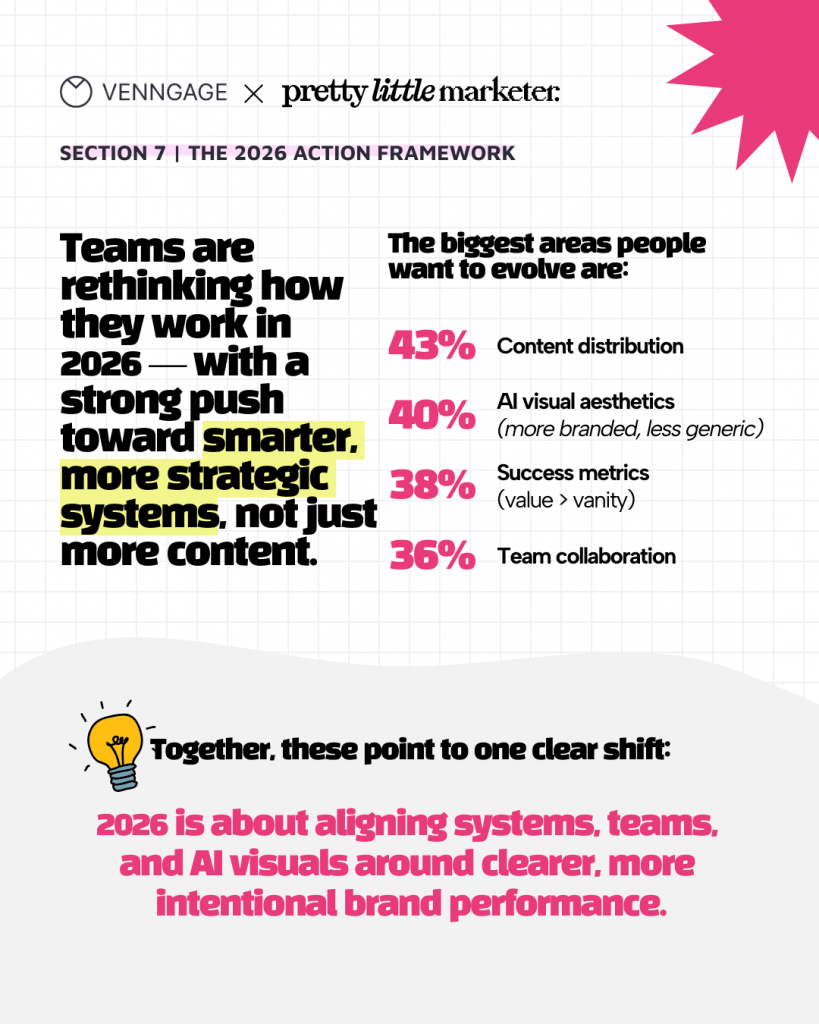
What this means
The action framework for 2026 points to a clear to-do list: refine social and visual identity, formalize AI as part of your core workflow, build skills in creative strategy and AI fluency, and upgrade distribution and measurement so content, not volume, drives performance.
Nefise Tasdelen, a sales and marketing strategist, reminds us that sustainable momentum is built on clarity, boundaries and better systems — not constant activity. Slowing down with intention helps teams move accurately instead of frantically, and the 2026 priorities reflect exactly that shift.
Here’s what Tasdelen recommends:
- Audit your reality, not your goals: When you’re overwhelmed, the issue is rarely that your goals are too big. It’s that your current systems can’t support them. Write down what your day actually looks like: what drains you, what distracts you, what feels forced, and what used to excite you but doesn’t anymore.
- Define your enough: Survival mode convinces you that more is always better: more output, more clients, more visibility. Instead, decide what “enough” looks like for revenue, clients, workload and presence. Once you know that, you stop chasing everything and start choosing the right things.
- Fix one friction point at a time: Looking at the whole mess feels impossible. Looking at one friction point feels doable. Don’t rebuild your entire brand or strategy in one go. Pick the one change that would bring immediate relief and start there. Small repairs create big clarity.
- Build slower foundations for faster growth: Many systems are built for speed, not sustainability. Strengthen the base instead by setting clearer boundaries, cleaner processes, sharper positioning and more intentional decision-making. When the foundation is solid, momentum becomes a choice, not a panic response.
Emerging signals: What’s next
Up to now, we’ve looked at how teams are working and what they plan to change in 2026. The signals in this final section sit one step further out: heavier use of AI-generated video, content that adapts in real time, more immersive product and data experiences, and AI systems that behave like a decision layer in the stack.
These patterns help you decide where to pilot new ideas (AI video, adaptive formats), which capabilities you’ll need to build toward (speed with quality, data storytelling, proprietary brand systems) and where human judgment, ethics and governance need to stay firmly in the loop as automation gets smarter.
Key findings
1. Content is drifting toward adaptive, AI-shaped experiences
The clearest pattern is a move toward content that adjusts itself to the person on the other side. Experiences are becoming more personalized, platform-native and low-friction, with AI doing the heavy lifting on adaptation.
Signals to watch
- 56% point to AI-generated video at scale as the strongest trend, shifting video from manual production to automated, template-driven workflows.
- 39% highlight hyper-personalized visuals.
- 33% point to real-time AI content adaptation.
- 32% call out voice and audio-first formats as rising priorities.
Immersive techniques are also gaining ground:
- 27% are leaning into 3D product experiences.
- 23% into interactive data storytelling.
Smaller but meaningful shifts reflect changing audience behavior:
- 12% call out zero-click, in-platform content.
- 11% mention employee-generated content.
- 9% focus on micro-communities over mass reach.
- 9% mention visual search and LLM optimization.
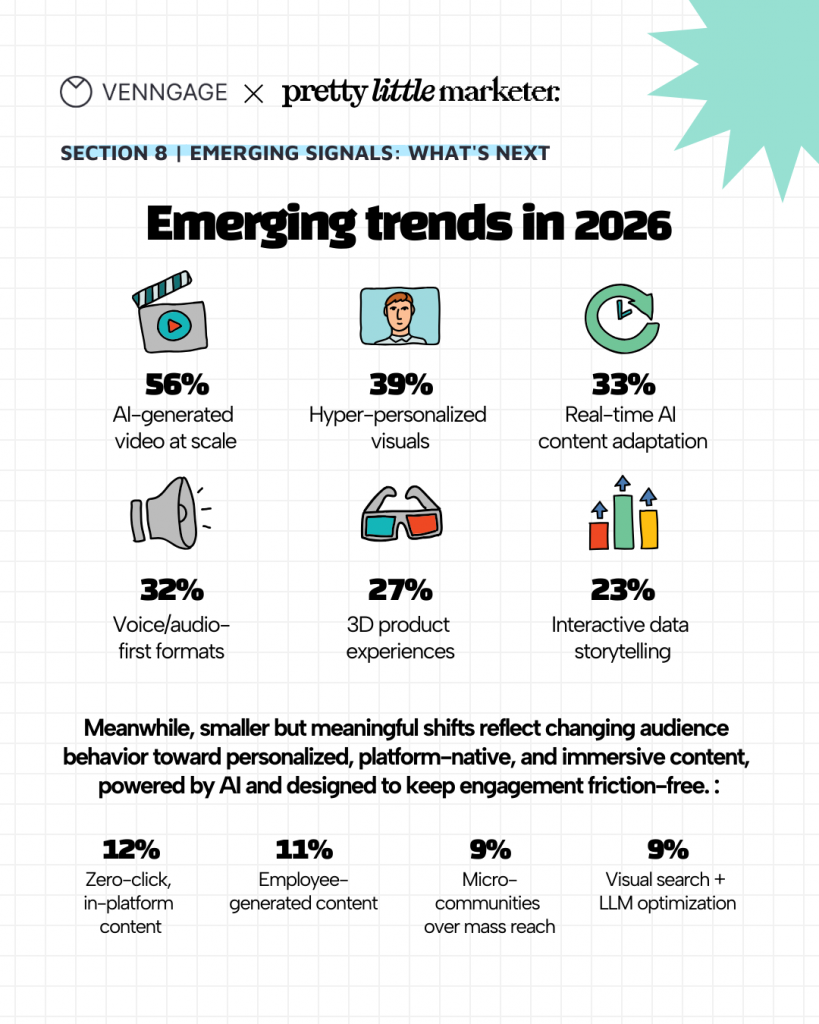
2. The must-have capabilities for high-performing teams
Teams that expect to stand out are focusing on capabilities that blend speed, brand depth and clearer thinking.
Top differentiators
- 39% say “speed with consistent quality” is the most important capability, putting process and standards under the spotlight.
- 34% highlight data storytelling and insight communication.
- 28% point to proprietary brand systems AI cannot easily copy.
Other rising differentiators:
- 22% emphasize strategic AI integration — using AI intentionally across workflows.
- 21% value cross-platform content adaptation.
- 19% call out authentic community engagement.
Smaller but notable signals:
- 9% mention accessibility expertise.
- 5% highlight creative originality in an AI-saturated environment.
3. Where most experimentation is happening
Roughly 65% of responses cluster around AI experiments, from content and visual generation to video editing, predictive analytics, prompting systems and automation.
Teams mention AI content creation, AI video editing and software, AI-generated visuals, AI automation and engineering, AI predictive analytics, AI-generated surveys, AI-powered optimization and “AI first + first-party data” setups.
Beyond AI, a smaller group is experimenting with:
- New storytelling formats
- Emerging social formats
- Sustainability-focused design
Early 2026 is an AI sandbox. Most teams are using it to stress-test workflows and discover where automation actually helps, while a smaller group is stretching format and sustainability boundaries.
The underestimated transformations of 2026
Many respondents believe the most overlooked shift is how deeply AI will embed itself into everyday marketing and design.
How people expect AI to evolve:
- Around 55% of responses point to AI becoming deeper, smarter and more autonomous.
- The expectation is not simply “more AI,” but AI that anticipates problems, adjusts content in real time and automates broad, generalist tasks.
Alongside this, a smaller but important group expects:
- Rising focus on human-centered creativity, emotional design, sustainability and trustworthy AI governance as counterweights to heavy automation.
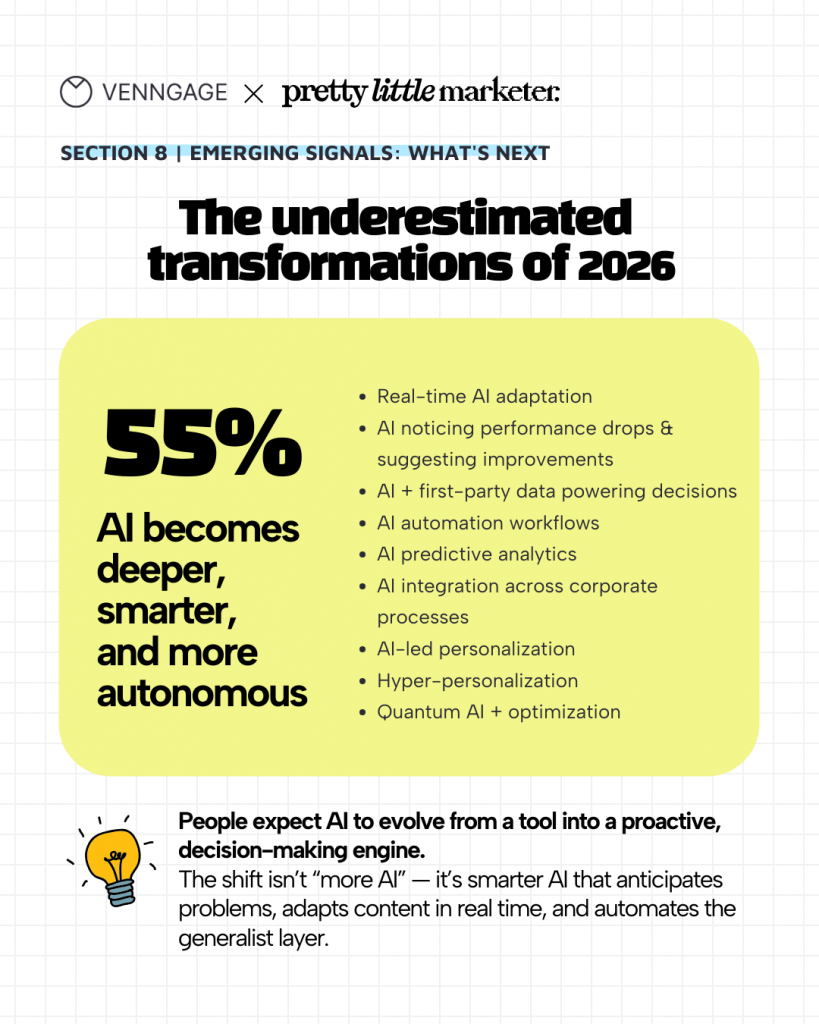
What this means
These signals point to a future that is more adaptive, more automated and more dependent on how well teams manage the gap between scale and meaning.
As Kate Radcliffe-Reid, CEO of Backkr, explains, thriving businesses in 2026 will belong to people who can “see the big picture while staying really close to human problems.”
“Really understand your customer. Where are they already hanging out online (and in person)? Go to them. Get to know them and solve their problem. Sometimes this needs AI guidance, sometimes it doesn’t.”
Kate Radcliffe-Reid, CEO of Backkr
A few clear implications:
- Plan for adaptive content, not just static assets: AI video, personalized visuals and real-time adaptation will demand modular scripts, reusable visual systems and clear rules for what can change and what stays fixed.
- Build capabilities that are hard to copy: Speed with consistent quality, strong data storytelling and proprietary brand systems give you something AI tools alone cannot: a point of view that feels specific to your team.
- Use AI experimentation to shape real workflows: The current sandbox phase is useful only if it turns into documented, repeatable processes. Treat experiments as input to new playbooks, not one-off stunts.
- Balance automation with human signals: As AI becomes more autonomous, the brands that stand out will be the ones that pair it with thoughtful choices on creativity, accessibility, sustainability and governance – areas where trust is built, not just output.
Closing thoughts: 2026 is the year of deliberate marketing
If 2025 was about trying everything, 2026 is about deciding what you’re willing to stand for and systemise. AI is shifting from experiment to infrastructure, social is consolidating around a few visual-first stages, and design is moving toward more human, story-led aesthetics. The question isn’t “What’s new?” so much as “What do we want to do on purpose?”
In practice, that means getting clear on a few things: the channels you’ll actually show up on, the visual system that makes you recognisable, and the parts of your workflow where AI has a defined, consistent role. Tighten your scorecard so it rewards resonance, not just reach. Turn the experiments that worked in 2025 into playbooks and templates instead of one-off wins.
Above all, keep the human layer close. The brands that will feel strongest in 2026 will use AI for speed and structure, but keep people in charge of story, ethics, accessibility and community. You don’t need to fix everything at once — pick a handful of moves, make them repeatable, and let the systems you build do the compounding.




























